Music is the universal language
“Glory to God in the highest heaven, and on earth peace to those on whom his favor rests.” - Luke 2:14
Premier Guitar
Pedalmania Round 2! Brothers AM + Knife Drop + Stinger Overdrive
Tom Butwin is back with round two of Pedalmania 2025!
First, he demos the versatile Chase Bliss Brothers AM, a collaboration with Analog Man that packs the beloved King of Tone sound into a compact powerhouse. Next, experience the unique and wild sounds of Eventide's Knife Drop, a collaboration with Third Man that delivers crushing distortion and synth tones. Finally, explore the simple but effective Rock N Roll Relics Stinger Overdrive, an old-school pedal with new old stock parts that offers a wide range of usable tones—from a clean boost to searing leads.

Eventide Knife Drop Suboctave Fuzz Synth Pedal
.rbm-pick-card { --rbm-border: ; --rbm-accent: ; border: 2px solid var(--rbm-border, #e53e3e); border-radius: 10px; padding: 16px; background: #fff; font-family: inherit; position: relative; } .rbm-pick-badge { position: absolute; top: -10px; left: 12px; background: var(--rbm-accent, #e53e3e); color: #fff; font-size: 12px; line-height: 1; padding: 6px 10px; border-radius: 6px; font-weight: 700; } .rbm-pick-wrap { display: grid; grid-template-columns: 110px 1fr; gap: 16px; align-items: start; } .rbm-pick-img { aspect-ratio: 1 / 1; /* forces square crop */ overflow: hidden; border-radius: 6px; background: #f3f4f6; /* subtle placeholder */ } .rbm-pick-img img { width: 100%; height: 100%; object-fit: cover; /* crops without distortion */ display: block; } .rbm-pick-title { margin: 0 0 4px; font-size: 20px; font-weight: 800; color: #111; } .rbm-pick-sub { margin: 0 0 12px; font-size: 14px; font-weight: 700; color: #334155; } .rbm-pick-btns { display: grid; gap: 10px; max-width: 560px; } .rbm-pick-btns a { display: block; text-align: center; background: #000; color: #fff !important; text-decoration: none; padding: 12px 14px; border-radius: 8px; font-weight: 800; letter-spacing: .3px; } .rbm-pick-btns a span.price { text-transform: none; } .rbm-pick-btns a span.label { text-transform: uppercase; } /* Responsive */ @media (max-width: 560px) { .rbm-pick-wrap { grid-template-columns: 80px 1fr; } .rbm-pick-title { font-size: 18px; } }
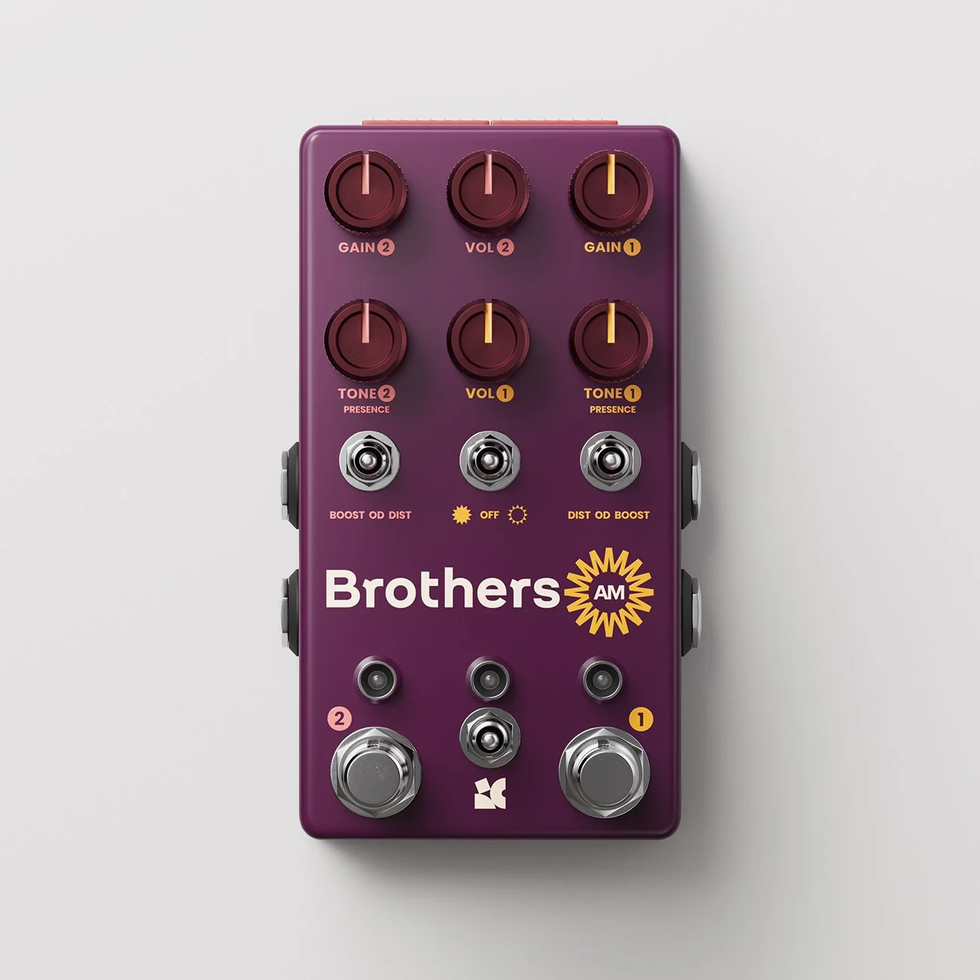
Chase Bliss Brothers AM
.rbm-pick-card { --rbm-border: ; --rbm-accent: ; border: 2px solid var(--rbm-border, #e53e3e); border-radius: 10px; padding: 16px; background: #fff; font-family: inherit; position: relative; } .rbm-pick-badge { position: absolute; top: -10px; left: 12px; background: var(--rbm-accent, #e53e3e); color: #fff; font-size: 12px; line-height: 1; padding: 6px 10px; border-radius: 6px; font-weight: 700; } .rbm-pick-wrap { display: grid; grid-template-columns: 110px 1fr; gap: 16px; align-items: start; } .rbm-pick-img { aspect-ratio: 1 / 1; /* forces square crop */ overflow: hidden; border-radius: 6px; background: #f3f4f6; /* subtle placeholder */ } .rbm-pick-img img { width: 100%; height: 100%; object-fit: cover; /* crops without distortion */ display: block; } .rbm-pick-title { margin: 0 0 4px; font-size: 20px; font-weight: 800; color: #111; } .rbm-pick-sub { margin: 0 0 12px; font-size: 14px; font-weight: 700; color: #334155; } .rbm-pick-btns { display: grid; gap: 10px; max-width: 560px; } .rbm-pick-btns a { display: block; text-align: center; background: #000; color: #fff !important; text-decoration: none; padding: 12px 14px; border-radius: 8px; font-weight: 800; letter-spacing: .3px; } .rbm-pick-btns a span.price { text-transform: none; } .rbm-pick-btns a span.label { text-transform: uppercase; } /* Responsive */ @media (max-width: 560px) { .rbm-pick-wrap { grid-template-columns: 80px 1fr; } .rbm-pick-title { font-size: 18px; } }
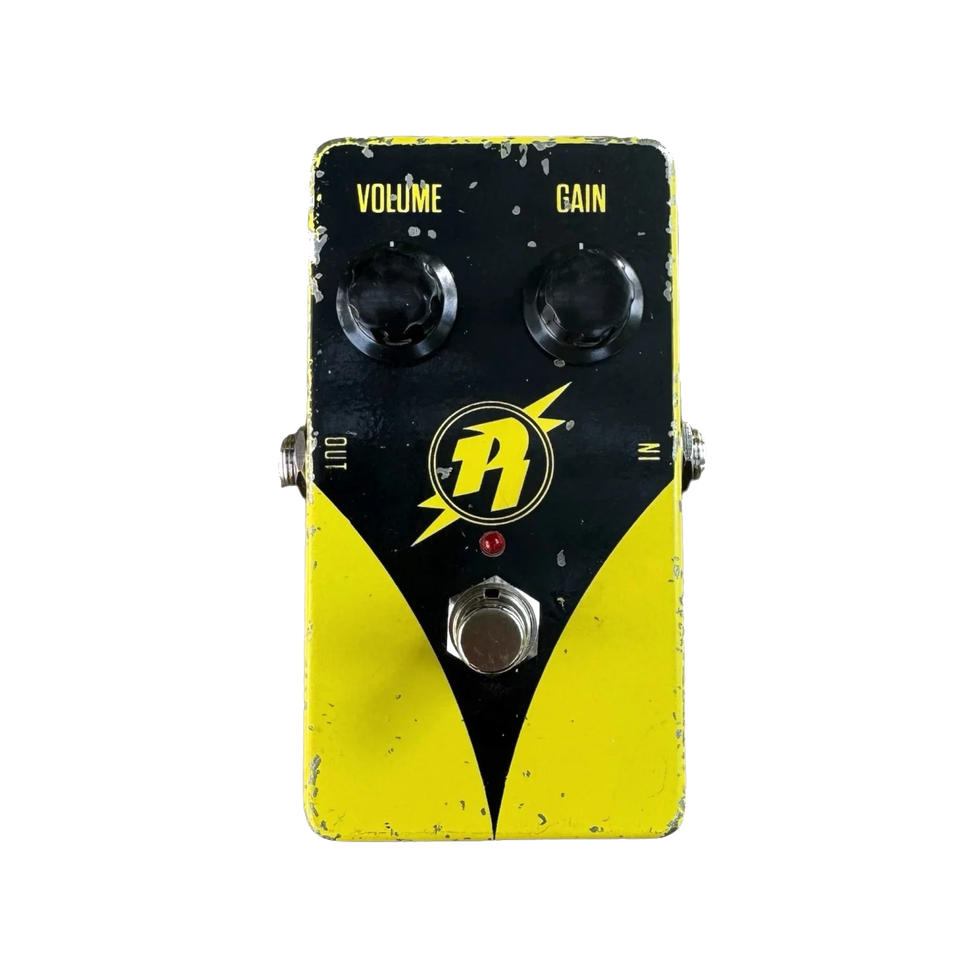
Rock 'N Roll Relics Stinger Overdrive
Heritage Guitars Launches The Standard II Collection
Continuing the company’s 40th anniversary celebrations, Heritage Guitars has introduced the Standard II Collection, a refinement of its original Standard Series, starting with the updated H-150 model.
With the Standard II Collection, Heritage Guitars reaffirms its commitment to continual improvement and refining every detail to deliver meaningful upgrades for today’s players, while staying true to its American-made legacy. The all-new H-150 under the Standard II Collection introduces several key enhancements in construction, tone, and versatility.
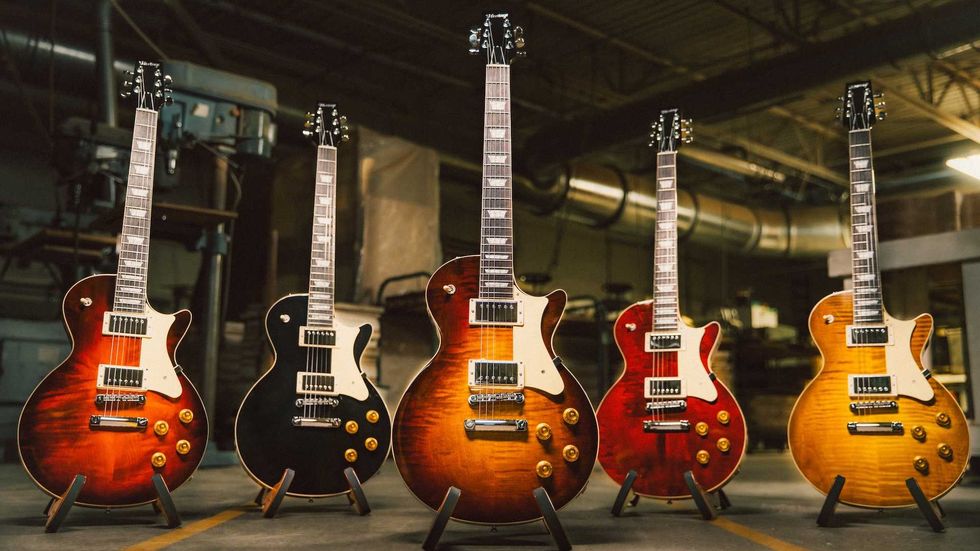
Key features include:
- Updated Headstock: A new headstock veneer featuring the ‘Heritage’ logo lends a more
- Weight Relief: The body is crafted from genuine mahogany with weight relief, offering greater playing comfort without compromising tonal integrity
- New Heritage Custom Shop 225 Standard Humbuckers: Designed and wound in-house, these pickups deliver a broad and expressive tonal range. Built with 42 AWG plain enamel wire (neck) or 43 AWG poly wire (bridge) on Butyrate unpotted bobbins, and 2.5” roughcast Alnico 5 magnets, they feature potted covers to minimize unwanted feedback at higher volumes
- Modern Wiring: Equipped with series/parallel switching via push/pull tone pots, this setup provides expanded tonal flexibility, capturing the brightness and clarity of a “single-coil” voice without the typical volume loss of traditional coil-splitting
- ’60s Neck Profile: A slim, comfortable profile that maintains ample grip for a familiar, vintage-inspired feel
- New Finishes: Offered in striking new colorways Wine Red, Bourbon Burst, and Chestnut Burst, alongside existing favorites Dirty Lemon Burst and Ebony
- Made in the USA: Crafted at 225 Parsons Street, Kalamazoo, Michigan
The Standard II H-150 launch marks another milestone in a landmark year for the brand, which also saw the debut of the critically acclaimed Custom Shop H-717 archtop and the Ascent Collection, a line of accessible instruments designed to bring Heritage’s renowned craftsmanship to a wider audience.
The Heritage Standard II H-150 is priced at $2,599 (US MAP). For more information, visit heritageguitars.com or contact select authorized Heritage dealers.
Heritage Guitars Launches The Standard II Collection
Continuing the company’s 40th anniversary celebrations, Heritage Guitars has introduced the Standard II Collection, a refinement of its original Standard Series, starting with the updated H-150 model.
With the Standard II Collection, Heritage Guitars reaffirms its commitment to continual improvement and refining every detail to deliver meaningful upgrades for today’s players, while staying true to its American-made legacy. The all-new H-150 under the Standard II Collection introduces several key enhancements in construction, tone, and versatility.

Key features include:
- Updated Headstock: A new headstock veneer featuring the ‘Heritage’ logo lends a more
- Weight Relief: The body is crafted from genuine mahogany with weight relief, offering greater playing comfort without compromising tonal integrity
- New Heritage Custom Shop 225 Standard Humbuckers: Designed and wound in-house, these pickups deliver a broad and expressive tonal range. Built with 42 AWG plain enamel wire (neck) or 43 AWG poly wire (bridge) on Butyrate unpotted bobbins, and 2.5” roughcast Alnico 5 magnets, they feature potted covers to minimize unwanted feedback at higher volumes
- Modern Wiring: Equipped with series/parallel switching via push/pull tone pots, this setup provides expanded tonal flexibility, capturing the brightness and clarity of a “single-coil” voice without the typical volume loss of traditional coil-splitting
- ’60s Neck Profile: A slim, comfortable profile that maintains ample grip for a familiar, vintage-inspired feel
- New Finishes: Offered in striking new colorways Wine Red, Bourbon Burst, and Chestnut Burst, alongside existing favorites Dirty Lemon Burst and Ebony
- Made in the USA: Crafted at 225 Parsons Street, Kalamazoo, Michigan
The Standard II H-150 launch marks another milestone in a landmark year for the brand, which also saw the debut of the critically acclaimed Custom Shop H-717 archtop and the Ascent Collection, a line of accessible instruments designed to bring Heritage’s renowned craftsmanship to a wider audience.
The Heritage Standard II H-150 is priced at $2,599 (US MAP). For more information, visit heritageguitars.com or contact select authorized Heritage dealers.
Tubesteader Releases Gainlord Preamp/Overdrive
Tubesteader releases the Gainlord™, a dual-channel preamp/overdrive inspired by British amps from the late ’60s through the ’80s, the amps that defined hard rock.
Built on real high-voltage tube circuitry, it delivers the same punch, harmonic richness, and touch-sensitive response as the original amps — all in a compact pedal format.
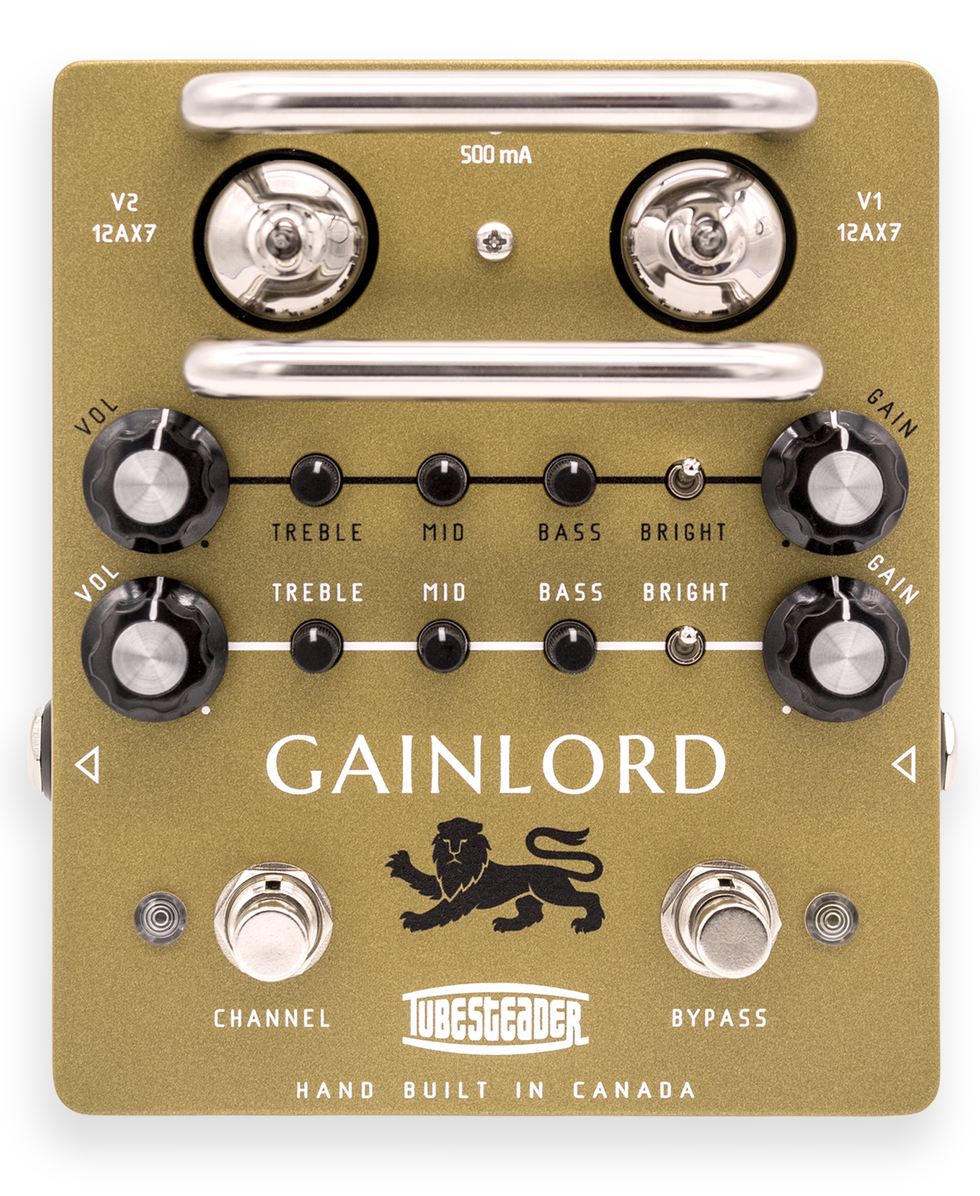
The low-gain channel is open and gritty, breaking up around 9 o’clock. Push it harder, and it develops a grainy crunch with sagging lows that add warmth and body. The high-gain channel is tighter and more aggressive, with defined notes and extra top-end bite, yet cleans up naturally when the guitar’s volume is rolled back. Both channels include a Bright switch for added presence; on the high-gain channel, it can also provide a subtle gain boost. A 3.5mm TRS jack allows remote control of channel switching and the high-gain Bright switch. The Tone Cut switch offers two modes: a full-output preamp for power amps or cab simulators, or a lower-level overdrive mode with scooped high-mids for front-of-amp use. Power is supplied via the included AC/DC adapter or any 12V DC, 500mA pedalboard supply.
The Gainlord can be used in front of an amp, into a power amp, or directly with a cab simulator. It comes with a wall-mount power supply and a country-specific plug. The Gainlord street price is $349 USD. Available at select retailers or directly from the Tubesteader online store www.tubesteader.com.
Strymon Introduces New Olivera Vintage Oil Can Echo
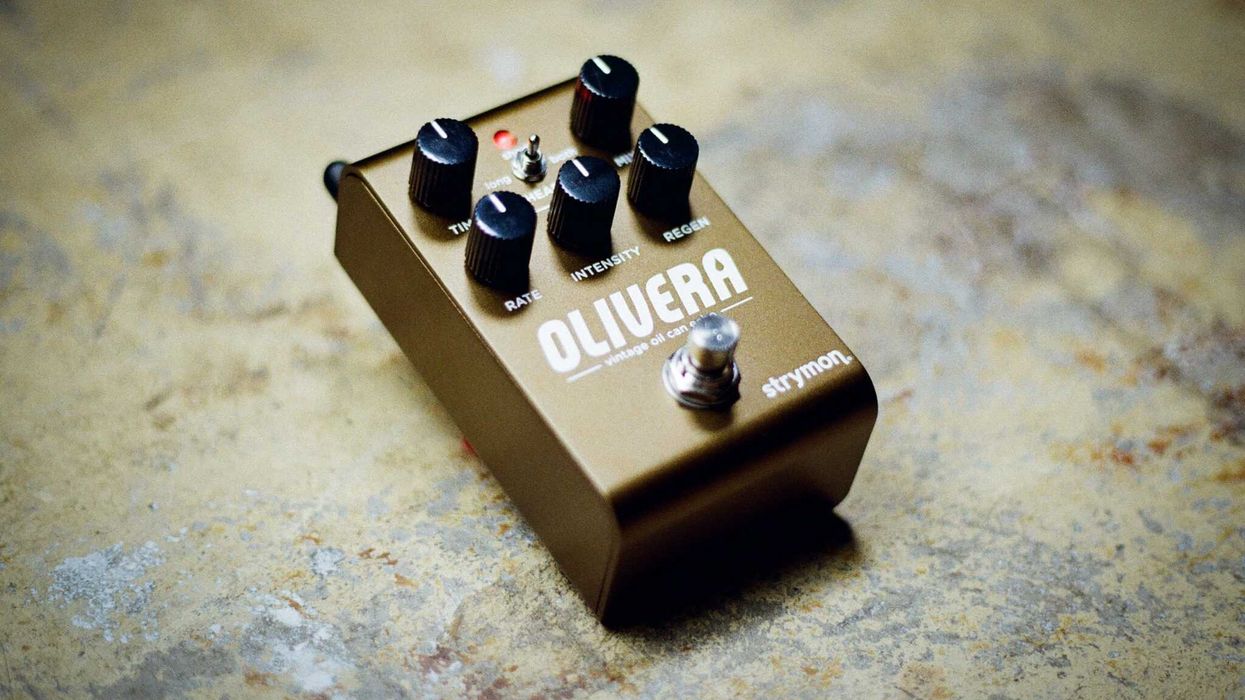
Strymon Engineering (www.strymon.net), theLos Angeles-based manufacturer of premium guitar, plugin and Eurorack products, todayannounced the arrival of their newest compact effects pedal, named Olivera. Based uponextensive research into what truly makes vintage oil can echo units tick, Olivera represents themost accurate reproduction of these devices ever offered in a compact form factor.
Oil can echoes like the classic Tel Rey® units actually used a motorized rotating can andlubricating oil to generate the murky repeats that they’re known for, creating a mountain oforganic variables that make recreating their behavior in software a major challenge. The resultof all of this research is a brand-new algorithm that has never before appeared in a Strymonproduct, capable of generating all of the organic chaos and vibe of the original units.All of the vintage flavor also comes with modern features like independent stereo processing of
the left and right inputs, full MIDI and expression control, stereo TRS ins and outs with multipleaudio routing modes and USB-C for firmware updates and computer control.
“This was a fun project to dig into and get right”, said Pete Celi, Strymon co-founder and DSPguru. “The sheer number of organic variations and interactions makes recreating the behaviorof a device like this pretty daunting, but that makes it even more rewarding when it all comestogether.”Celi continues, “I imagine that many folks would say that these units are simply filtered anddark, but it goes way beyond that. The way that these systems record and play back the signalresults in a really unique and magical ambience that doesn’t sound like anything else.”Olivera is available now directly from Strymon and from dealers worldwide for $259 US.For additional information visit https://www.strymon.net.
Fender Expands American Professional Series
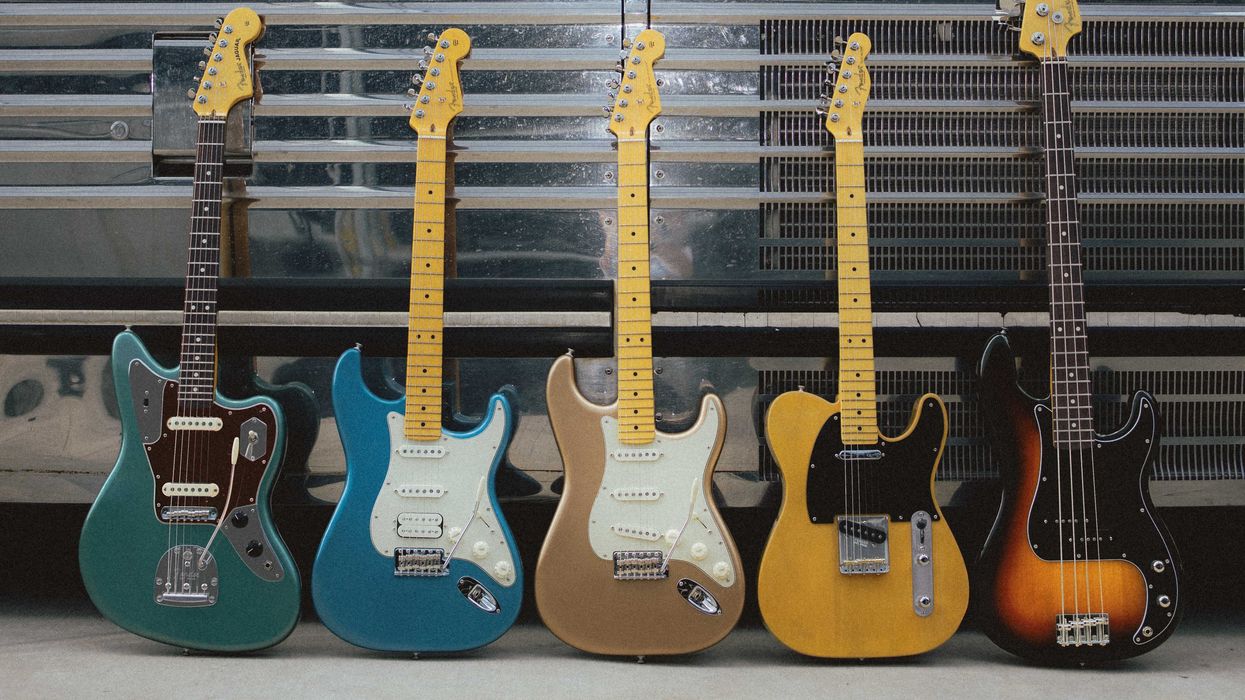
Fender Musical Instruments Corporation (FMIC) today announces the launch of the American Professional Classic, the newest evolution in Fender’s modern classic American Professional series and the embodiment of the brand’s legacy as the definitive leader in electric guitars. “Tested. Trusted. Night After Night.” this series is built for players who demand reliability, versatility and performance at the highest level. From first gigs in garages to global festival stages, across every genre and generation, the American Professional Classic delivers timeless Fender tone, precision craftsmanship and modern refinements that make it a trusted instrument for musicians everywhere.
Rooted in Fender’s heritage of American innovation, the American Professional Classic combines durability, adaptability and uncompromising playability. Its enhanced neck profile, all-new Coastline pickups, and upgraded hardware make it as comfortable to play in the studio as it is on tour, while classic finishes and bold color options ensure it looks as good as it sounds. Whether for seasoned professionals, emerging artists, or players exploring new sounds, this guitar is engineered to support creative expression, inspire performance and deliver consistency on every stage.
“The American Professional Classic is all about delivering a great playing experience,” said Max Gutnik, Chief Product Officer at FMIC. “We focused on every detail: from the all-new Coastline pickups, which offer clear, punchy tone across every register, to the Modern-‘C’ neck with rolled fingerboard edges that feels comfortably broken-in from day one. We combined vintage-inspired finishes and hardware with thoughtful upgrades like staggered ClassicGear™ tuners, Mustang saddles on the offsets, and slotted Telecaster barrel saddles. The result is a guitar that’s easy to play, sounds incredible and adapts to any style or stage.”
Music today is experiencing a powerful guitar-driven resurgence, with a new generation of artists bringing raw, garage-band energy onto the world’s biggest stages. Turnstile is one of the bands leading the charge, packing arenas with their genre-blurring sound and DIY ethos, while emerging musicians like Fleshwater and Horsegirl, who are both part of the Fender Next roster, embody that same spirit of rawness and edge. At the same time, fellow Fender Next artists Balu Brigada and DARUMAS showcase the artistic highs that define Pop Music in 2025 - trading riffs, building songs together, and sharing the joy of collective creativity. Across genres and styles, these artists and their fans are fueling a cultural moment where the guitar is further cemented as the heartbeat of live music.
The American Pro Classic was built for this moment, offering the sonic versatility to meet the demands of today’s artists, with its fearless spirit embodied by Turnstile, the Baltimore hardcore band fronting the campaign. Known for their explosive live shows and genre-defying sound, Turnstile showcases how the guitar empowers musicians to create boldly and connect deeply with fans. Yet the American Pro Classic’s appeal extends far beyond one band or one genre; it reinforces Fender’s role as a unifying force in music, delivering inspiration for artists everywhere.
“When you're in a different place constantly, sometimes the most familiar thing is the guitar that you bring every single night,” said Pat McCrory from Turnstile. “We look for something that sounds the same every time, sounds exactly how you want it, but also has versatility because spaces change. Sometimes you play outside, sometimes it sounds different, sometimes you play inside or there's noise lighting. Having some durability but flexibility is very important.”
Key upgrades include:
- All-New Coastline Pickups – slightly overwound Pure Vintage recipes and are engineered for clarity, punch, and dynamic expression, delivering Fender’s signature warmth and bite across every register, from subtle nuances to soaring leads.
- Enhanced Neck Profile – a comfortable Modern-‘C’ shape with rolled fingerboard edges designed for speed, fluidity, and long-playing comfort, adapting seamlessly to any style or technique.
- Upgraded Hardware & Tuning Stability – premium components including upgraded vintage bridges and precision ClassicGear™ tuning machines, ensure rock-solid tuning on stage and studio reliability for recording sessions.
- Classic Finishes in Bold Colors – a curated selection of timeless Fender finishes reimagined for modern players, combining iconic aesthetic appeal with fresh, vibrant options for the next generation of guitarists.
American Professional Classic Stratocaster

($1,499.99 USD, £1,499 GBP, €1,799 EUR, $2,599 AUD, ¥242,000 JPY)
The perfect blend of vintage charm and modern performance – the American Professional Classic Stratocaster®. Under the hood, vintage-inspired Coastline™ ’57 Stratocaster® pickups deliver depth, punch and sparkle while the sleek Modern “C” neck provides exceptional comfort and playability. Fender Staggered ClassicGear™ tuners provide classic looks and precise tuning stability. Boasting custom-faded vintage and signature Fender® finishes, this professional-grade instrument looks as good as it sounds. From studio to stage, The American Professional Classic Stratocaster® All the soul of a golden-era Fender®, evolved for today’s player. Options include Rosewood Fingerboard in Faded Black, Faded Dakota Red, Faded Sherwood Green Metallic as well as Maple Fingerboard in Faded Firemist Gold, Faded Lake Placid Blue and 3-Color Sunburst.
American Professional Classic Stratocaster HSS

($1,549.99 USD, £1,549 GBP, €1,849.00 EUR, $2,699 AUD, ¥264,000 JPY)
The perfect blend of vintage charm and modern performance – the American Professional Classic Stratocaster® HSS. Under the hood, vintage-inspired Coastline™ ‘57 Stratocaster® pickups and Coastline™ humbucker deliver depth, punch and sparkle while the sleek Modern “C” neck provides exceptional comfort and playability. Fender Staggered ClassicGear™ tuners provide classic looks and precise tuning stability. Boasting custom-faded vintage and signature Fender® finishes, this professional-grade instrument looks as good as it sounds. From studio to stage, The American Professional Classic Stratocaster® HSS All the soul of a golden-era Fender®, evolved for today’s player.Options include Rosewood Fingerboard in Faded Sherwood Green Metallic as well as Maple Fingerboard in Faded Lake Placid Blue, Faded Black and 3-Color Sunburst.
American Professional Classic Telecaster

($1,499.99 USD, £1,499 GBP, €1,799 EUR, $2,599 AUD, ¥242,000 JPY)
The perfect blend of vintage charm and modern performance – the American Professional Classic Telecaster®. Under the hood, vintage-inspired Coastline™ ’63 Telecaster® pickups deliver depth, punch and sparkle while the sleek Modern “C” neck provides exceptional comfort and playability. Fender Staggered ClassicGear™ tuners provide classic looks and precise tuning stability. Boasting custom-faded vintage and signature Fender® finishes, this professional-grade instrument looks as good as it sounds. From studio to stage, The American Professional Classic Telecaster® All the soul of a golden-era Fender®, evolved for today’s player. Options include Rosewood Fingerboard 3-Color Sunburst, Faded Black, and Faded Dakota Red as well as Maple Fingerboard in Butterscotch Blonde,Faded Sherwood Green Metallic and Faded Lake Placid Blue.
American Professional Classic Hotshot Telecaster

($1,549.99 USD, £1,549 GBP, €1,849 EUR, $2,699 AUD, ¥264,000 JPY)
The perfect blend of vintage charm and modern performance – the American Professional Classic HotShot™ Telecaster®. Under the hood, vintage-inspired Coastline™ ’63 Telecaster® and ‘57 Stratocaster® pickups deliver depth, punch and sparkle while the sleek Modern “C” neck provides exceptional comfort and playability. Fender Staggered ClassicGear™ tuners provide classic looks and precise tuning stability. Boasting custom-faded vintage and signature Fender® finishes, this professional- grade instrument looks as good as it sounds. From studio to stage, The American Professional Classic Hotshot Telecaster® All the soul of a golden-era Fender®, evolved for today’s player. Options include Rosewood Fingerboard in Butterscotch Blonde and Faded Sherwood Green Metallic as well as Maple Fingerboard in 3-Color Sunburst and Faded Lake Placid Blue.
American Professional Classic Jazzmaster

($1,599.99 USD, £1,599 GBP, €1,899 EUR, $2,799 AUD, ¥264,000 JPY)
The perfect blend of vintage charm and modern performance – the American Professional Classic Jazzmaster®. Under the hood, vintage-inspired Coastline™ ’65 Jazzmaster® pickups deliver depth, punch and sparkle while the sleek Modern “C” neck provides exceptional comfort and playability. Fender Staggered ClassicGear™ tuners deliver classic looks and precise tuning stability. Boasting custom-faded vintage and signature Fender® finishes, this professional-grade instrument looks as good as it sounds. From studio to stage, The American Professional Classic Jazzmaster® All the soul of a golden-era Fender®, evolved for today’s player. Options include Rosewood Fingerboard in 3-Color Sunburst, Faded Firemist Gold, Faded Sherwood Green Metallic and Faded Dakota Red.
American Professional Classic Jaguar
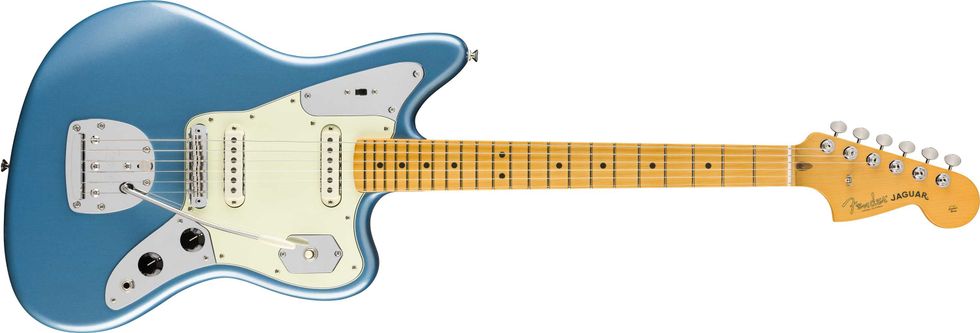
($1,599.99 USD, £X GBP, €1,899 EUR, $2,799 AUD, ¥264,000 JPY)
The perfect blend of vintage charm and modern performance – the American Professional Classic Jaguar®. Under the hood, vintage-inspired Coastline™ ’65 Jaguar® pickups deliver depth, punch and sparkle while the sleek Modern “C” neck provides exceptional comfort and playability. Fender Staggered ClassicGear™ tuners deliver classic looks and precise tuning stability. Boasting custom-faded vintage and signature Fender® finishes, this professional-grade instrument looks as good as it sounds. From studio to stage, The American Professional Classic Jaguar® All the soul of a golden-era Fender®, evolved for today’s player. Options include Rosewood Fingerboard 3-Color Sunburst, Faded Sherwood Green Metallic and Faded Firemist Gold as well as Maple Fingerboard in Faded Lake Placid Blue.
American Professional Classic Precision Bass

($1,599.99 USD, £1,549 GBP, €1,849 EUR, $2,799 AUD, ¥264,000 JPY)
The perfect blend of vintage charm and modern performance – the American Professional Classic Precision Bass®. Under the hood, the vintage-inspired Coastline™ ’60 split-coil Precision Bass® pickup delivers depth, punch and articulation while the sleek Modern “C” neck provides exceptional comfort and playability. Fender ‘lollipop’ tuners deliver classic looks and precise tuning stability. Boasting custom-faded vintage and signature Fender® finishes, this professional-grade instrument looks as good as it sounds. From studio to stage, The American Professional Classic Precision Bass® All the soul of a golden-era Fender®, evolved for today’s player. Options include Rosewood Fingerboard in Faded Sherwood Green Metallic and 3-Color Sunburst as well as Maple Fingerboard in Faded Lake Placid Blue.
American Professional Classic Jazz Bass

($1,599.99 USD, £1,549 GBP, €1,849 EUR, $2,799 AUD, ¥264,000 JPY)
The perfect blend of vintage charm and modern performance – the American Professional Classic Jazz Bass®. Under the hood, vintage-inspired Coastline™ ’62 Jazz Bass® pickups deliver depth, punch and articulation while the sleek Modern “C” neck provides exceptional comfort and playability. Fender ‘lollipop’ tuners deliver classic looks and precise tuning stability. Boasting custom-faded vintage and signature Fender® finishes, this professional-grade instrument looks as good as it sounds. From studio to stage, The American Professional Classic Jazz Bass® All the soul of a golden-era Fender®, evolved for today’s player. Options include Rosewood Fingerboard in Faded Firemist Gold and 3-Color Sunburst as well as Maple Fingerboard in Faded Dakota Red.
American Professional Classic Mustang Bass

($1,599.99 USD, £1,499 GBP, €1,799 EUR, $2,799 AUD, ¥264,000 JPY)
The perfect blend of vintage charm and modern performance – the American Professional Classic Mustang® Bass. Under the hood, the vintage-inspired Coastline™ ‘70 Mustang® Bass split-coil pickup delivers depth, punch and articulation while the sleek Modern “C” neck provides exceptional comfort and playability. Fender ‘lollipop’ tuners deliver classic looks and precise tuning stability. Boasting custom-faded vintage and signature Fender® finishes, this professional-grade instrument looks as good as it sounds. From studio to stage, The American Professional Classic Mustang® Bass All the soul of a golden-era Fender®, evolved for today’s player. Options include Rosewood Fingerboard, 3-Color Sunburst and Faded Sherwood Green Metallic as well as Maple Fingerboard in Faded Dakota Red.
Stompboxtober 2025: PRS

Bring clarity and grit together! Enter today’s #Stompboxtober giveaway for your chance to WIN the PRS Horsemeat transparent overdrive — add harmonic midrange richness and overdrive without losing your highs. Dial it as a clean boost or up the gain — it’s all about preserving your tone. Come back tomorrow for another pedal shot!
Stompboxtober 2025 - Win Pedals All Month Long!
PRS Horsemeat
The PRS Horsemeat transparent overdrive pedal is designed to enhance your sound without coloring your tone. Horsemeat adds harmonic midrange richness and overdrives without cutting out your high notes – all while giving you more available headroom. It features a robust EQ section so you can dial in your tone and has a wide range of gain on tap. Depending on the setting, Horsemeat can be used as a clean boost, straight overdrive, or even enhance your amplifier’s distortion by slightly pushing the front end of the amplifier’s preamp section.
PRS pedals were created to be high-end pieces of audio gear.

PRS Horsemeat Transparent Overdrive Pedal
Strings, Sweat, and Survival: An Insider Look at the World of a Guitar Tech
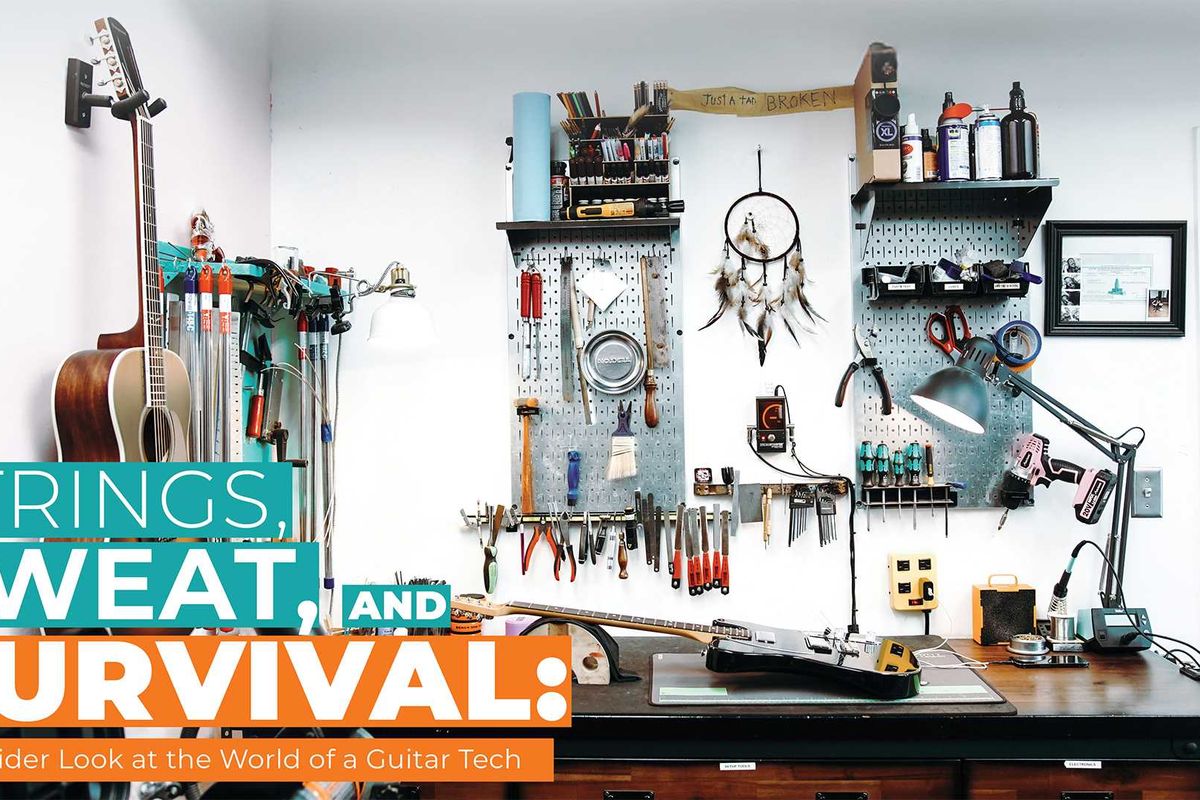
The life of a guitar tech is equal parts craft, chaos, and on-the-fly problem-solving. Though Ryan Chan, Luis Munoz, and Drew Foppe share this whirlwind existence, their unique paths—and the gigs those paths have led to—highlight just how varied and demanding it can be.

Chan’s journey began long before he was wrangling digital and hybrid rigs for bands like Loathe and Spiritbox. Growing up in Hong Kong, he dreamed of music production, though a move to the U.K. would quickly alter that goal. Munoz took a more deliberate path, landing in Hollywood and sharpening his skills as a luthier before finding himself in the middle of pop-rock’s great revival working for Olivia Rodrigo. Foppe, meanwhile, initially had no desire to work in music, but he still found himself pulled into a decades-long career with some of the biggest names in the business.
These three techs come from very different places, both professionally and geographically. Still, their stories converge in the relentless grind of touring life, full of long days, constant travel, and endless hours working behind the curtain to keep internationally-known guitarists playing and sounding their best. Here, they step out from behind that curtain to discuss the stories, rigs, and realities that shape a life lived just out of the spotlight.
Ryan Chan (Loathe, Spiritbox)
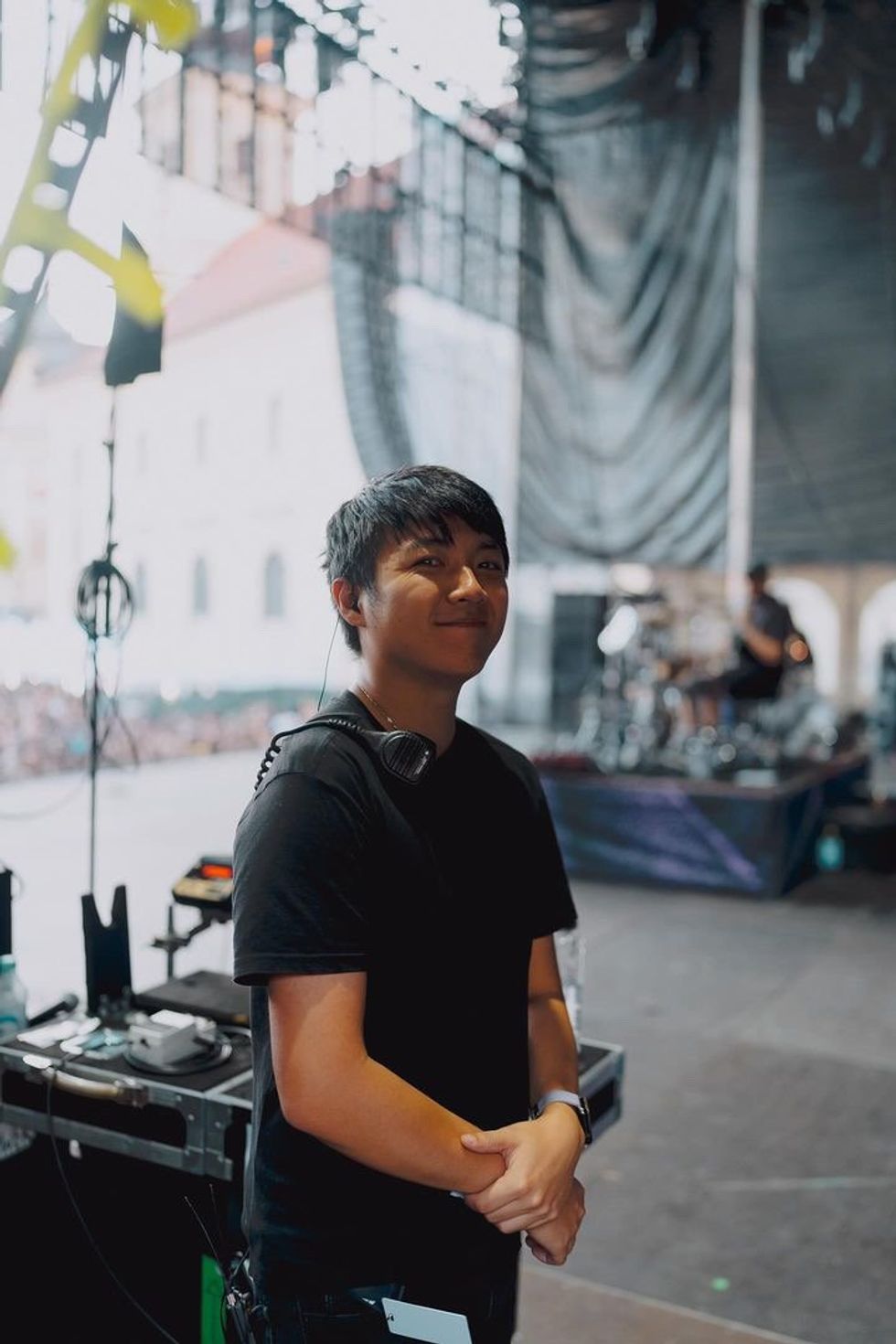
You were born in Hong Kong and literally moved halfway across the world to start your career. Tell me about that journey and how you became a guitar tech.
Ryan Chan: I wanted to be a producer, so I came to Leeds six years ago because of music university, where I joined the music production program. There was one guy in my course named Adam, who’s a good friend of mine, and he was a front-of-house engineer for Loathe. I think at one point they needed a tech, and he was like, “You like to mess with guitars. Come do it with me on the road.” And that’s how it all started.
You’re currently working with Loathe and planning a big North American tour. What’s a day in the life for you when you’re out with them?
Chan: We don’t load in until maybe 2 o’clock. From there, it’s just kind of getting everything set up. I get all the pedalboards laid out and everything else ready to be thrown on the stage. Then it’s soundcheck, show, and then pack down, and on to the next show. I usually restring the guitars maybe once every three to four days.
As of this next tour, they’re also having me more involved outside of just the touring stuff. Like, two days ago, I was at Loathe’s new space helping program some sets with the playback and MIDI stuff.
Loathe showcased some of their unique guitars and equipment on one of our Rig Rundowns. What are they taking out these days?
Chan: There are four guitars and four basses. Some of them are spares that get used depending on how they’re feeling that day. We don’t carry different guitars with different tunings. They use multiple tunings, but they’ll tune everything themselves. The main variation is, one’s a baritone and one’s a normal-scale guitar. And I’m the only backline tech, so I’m also the one who looks after all their MIDI keyboards and stuff, too.
Loathe still use tube amps, although a lot of bands have turned to digital modelers for touring. How has the rise in digital touring rigs affected your work?
Chan: I’m used to it. Digital’s reliable, and it’s predictable. You’re not rolling the dice every time you put the amp in the trailer. When I worked with Spiritbox, they’ve always been all digital.
But with Loathe, it’s actually an interesting hybrid of [Fractal] Axe-Fx and amps. Eric [Bickerstaffe] plays with a [Marshall] JCM800 and treats the Axe-Fx as a big front-end pedalboard. Faisal [El-Khazragi], the bass player, uses an Ampeg SVT. But I believe, for this next tour, we’re actually switching back to Axe-Fx for pure simplicity. I guess, maybe more so for bass, the trade-off is worth it.
You’re still in the early part of your career. Are there any lessons you’ve learned on the road that make you better at your job?
Chan: One thing I’ve had to learn is how to communicate and ask people for help, rather than waiting for someone higher up to do the asking for me. You’ve gotta be a bit more assertive, and be like, “All right, here’s an issue. I need to go find the people that will help me fix this issue.” Also, if I’m gonna say no to something, I’d better have a really good reason as to why we can’t do it.
Talk about the reality vs. the expectation of being a touring guitar tech.
Chan: I don’t want to undersell it, but it’s not as glamorous as people might want to make it out to be. It is very much a job. When you first get into it, it’s so fresh, and it’s so exciting. It’s so fun. Then suddenly that wears off, and you have to look at it as a responsibility. So learning to enjoy the road again has been a fun experience for me.
The three tools Ryan Chan can’t live without:
● Dunlop String Action Gauge
● Multi-bit screwdriver
● USB-powered soldering ironLuis Munoz (Olivia Rodrigo, Smashing Pumpkins, Bush, LP)

Your goal was always to be a guitar tech. But how did you get your foot in the door in such a competitive industry?
Luis Munoz: It’s a hard community to get into, but once you’re in, you’re in forever. So I remember thinking to myself, “I’m going to become undeniable and really good at what I do.” So, I went to Guitar Craft Academy in Hollywood and started working in shops around town. But I always wanted to go on tour. Then one of my clients and another buddy got me a gig, and I went on my first tour for an artist that goes by the name of LP. Just like that, I started getting call after call.
You’ve worked for some massive rock bands. But working in a huge pop production like Olivia Rodrigo’s has to be a lot different. What’s a typical day in that camp look like?
Munoz: My days would start with changing strings and doing all the stuff that I need to so that, when the stage is rolled into place, we can start plugging in, patching, and making sure everything works. We do a quick line check, and then the band would come out and run a song or two. Then you hurry up and wait until it’s your time to do a show.
Doing the show is, I feel, what’s different in the pop world versus the rock world. I was part of the show. I would hand [Olivia] the guitar way out at the end of the thrust. Then I’d have to run that whole thing back, and, when she’s literally about to hit the chord, I would hit the unmute button. Then, when she’s done, I’d mute it, go on stage, and she’d throw me the guitar. After every show, I’d be drenched in sweat, like I just worked out.
Olivia is featuring a ton of guitar in her shows these days, and you’re responsible for three players, including your wife, bassist Moa Munoz. What kind of gear does the production require?
Munoz: Olivia loves rock and wants to try different things. So, this last tour we went from having two guitars to seven. It’s another funny pop-world thing, but we had different guitars for different outfits.
And yeah, I would also take care of my wife, Moa, who had five basses, and Daisy [Spencer], the second guitar player. She was doing a lot of acoustic stuff, but said, “I want to play electric on this tour.” I thought the [Ernie Ball Music Man] St. Vincent might look cool, and she was like, “Fuck yes. That’s the one!”
Ariana [Powell, guitar] also had a whole guitar boat to herself. My buddy takes care of her on stage right.
With such a choreographed production, are you guys using digital amp modelers?
Munoz: Definitely, I don’t think people understand how many variables you have to deal with when using amps. Everything from if the power is different to amps going from a trailer to a sea container to a plane to a bus. So Daisy and Ari were on Kempers, and then Moa was on Helixes. It’s all MIDI-controlled, because even the band actually has choreography now.
Tell me about a humbling experience or a lesson you learned on the road that made you better at what you do.
Munoz: When I was still doing local repairs and things, [Bush guitarist] Chris Traynor’s tour manager called me and asked, “Have you ever been on tour as a tech?” And I was like, “You know what? No. But I can’t imagine it being hard.” I remember he was like, “Did you just say it was going to be easy? I don’t think this is gonna work out.” [Laughs.] I was trying to sound overly confident. But, funny enough, a year or two later, Chris hit me up again, and I actually tech’d with Bush.
For people wanting to get into your world, what’s a reality of the job they should prepare for?
Munoz: It’s different hats when you’re a luthier and when you’re a tech on the road. Being a tech has helped me to not be so precious. You know, “If you’ve got a stripped strap button, you can’t just shove toothpicks in there and super glue.” And it’s like, of course not—in a perfect situation. But sometimes you just need to get it fixed.
The three tools Luis Munoz can’t live without:
● DeWalt electric gyroscopic screwdriver
● Sonic Research Turbo Tuner
● Music City Bridge “Quick Flip” SaddledriverDrew Foppe (Shinedown, Slipknot, Deftones, Shakira, Fleetwood Mac)
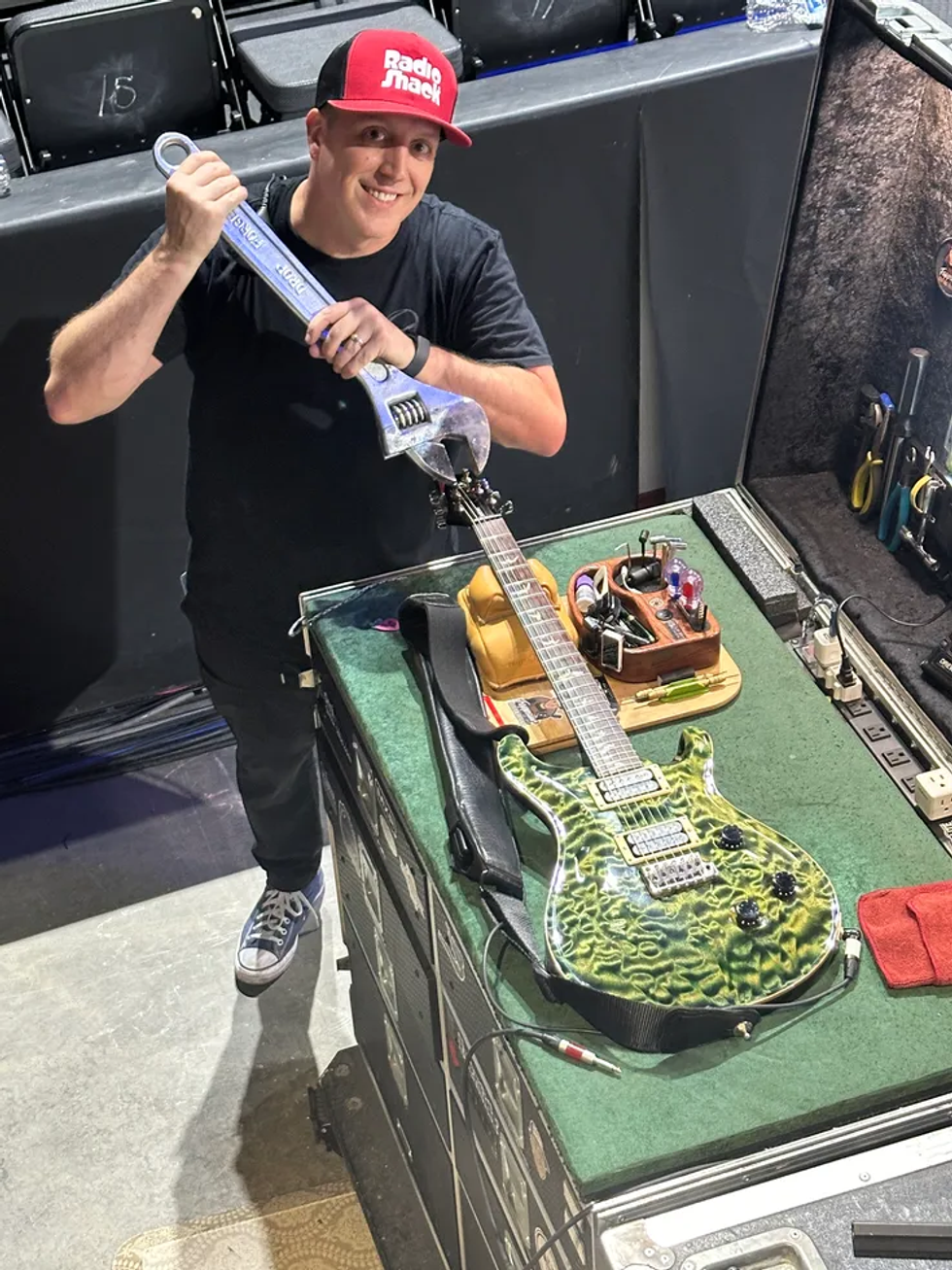
You earned a soccer scholarship and degrees in mathematics and psychology. How did you end up as a guitar tech?
Drew Foppe: I never planned to really be involved in music, ever. I wanted to do social work. But guitar kind of took over, and I just started following it. I got into a band and did that for about a year and a half. About five days after I quit, my buddies said, “Hey, why don’t you tech for Opiate for the Masses?” I was like, “What’s a tech?” [Laughs.] So I became a guitar tech, and haven’t stopped in almost 25 years.
Now you’re on the road with Shinedown, one of the biggest rock bands of the past few decades. What does a typical day look like for you when you’re on tour?
Foppe: When I get in, I immediately go and set up the warm-up room. The next hour and a half or so, I’ll change strings. That takes about three hours to do all 20 guitars. After I get done, I’ll get all the gear in position and start running all the cables for the keyboards, pedalboards, and all that stuff. Then it takes about 20 minutes to change all the wireless packs to the correct frequencies. Shortly after that, we line-check the gear with a crew jam. Everything’s pretty dialed at this point.
When the show starts, every single song is a guitar change, and they have four stages. I do about 10 to 12 miles of steps during a show!
Zach Myers’ love for gear is well known in guitar circles. Tell me about the rig you handle for him every show?
Foppe: We’re getting eight channels from Zach. There are three electric wireless lines and one acoustic. The acoustic goes out to a Fishman DI. The electric goes to two pedalboards. I have one in my tech world and one on the stage. From the boards, it goes to the [Fractal] Axe-Fx III. And from the Axe-Fx, we’re using Synergy power amps that hit two 112 ISO cabinets. We also send the amps to UA OX Boxes with a modeled 112 open back cabinet. Then there’s the outs from the Axe-Fx.
Digital modelers are usually employed to simplify signal chains. You obviously use them very differently. Do you pick a side in the digital vs. analog debate?
Foppe: I was probably right in the heart of when analog and digital were fighting for commonplace in the industry. Digital just gave you more options. Transitioning between the two, I think they’re integrated so well now that I don’t think it matters. I’ve done both for the biggest artists in the world, and stadium artists use digital and stadium artists use analog. They just use what they like and what they’re comfortable with.
You’ve worked with some incredible artists across multiple genres. Is there a secret to getting called back for the next artist or tour?
Foppe: I truly believe that having a psychology degree has helped me navigate these waters. When you’re working with artists who know exactly what they want, you just gotta listen and take it all in instead of coming in like, “I can do whatever. I can’t do whatever.” I think if you just listen to what people are saying, that gives you a good head start. That’s what really helps you grow as a tech and get other jobs.
Surrounding yourself with music, gear, and travel sounds romantic, but what are some truths about teching that you’d like to share with people considering it as a career?
Foppe: The first thing you’ve got to do is learn the craft of guitar repair, amp repair, programming, signal flow, and troubleshooting. All that stuff comes before you actually get a job. But the work aspect is only maybe 40 percent of the job. Working well with people and being self-motivated is pretty much everything else.
It’s also long hours, being away from your family, and you start to almost change your friend groups. That’s why they call it your “tour family.” So learning guitar skills, working well with people, and being okay to work when you’re tired is ultimately the key to being a guitar tech.
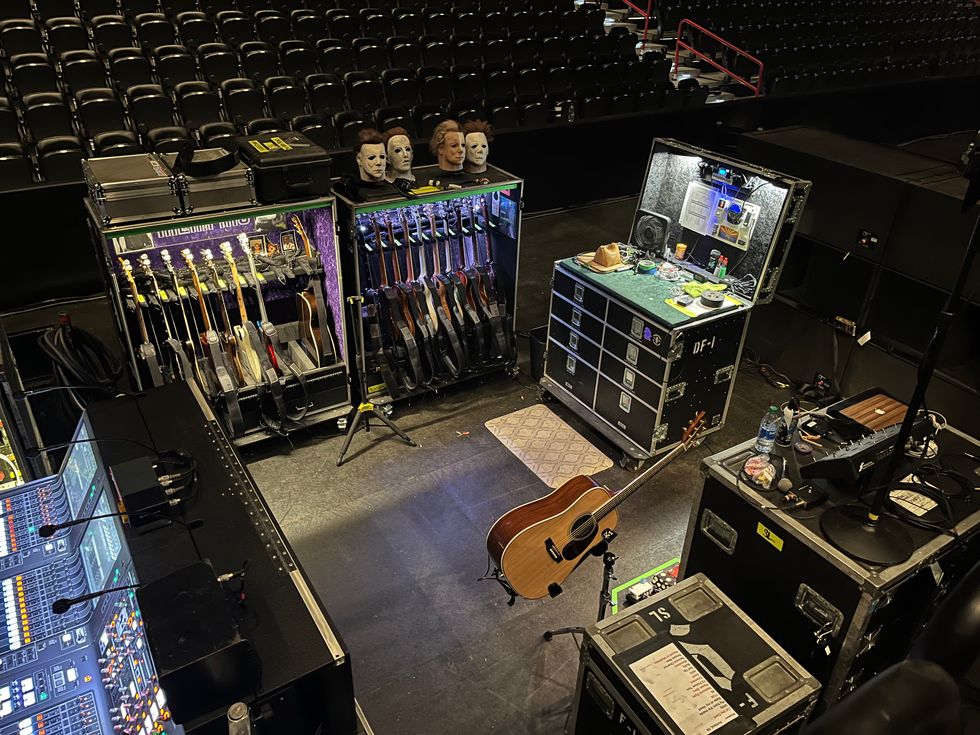
The three tools Drew Foppe can’t live without:
● Peterson Strobe Tuner
● Music Nomad String Action Gauge
● EarplugsWe Could All Stand to Learn More From the Bass
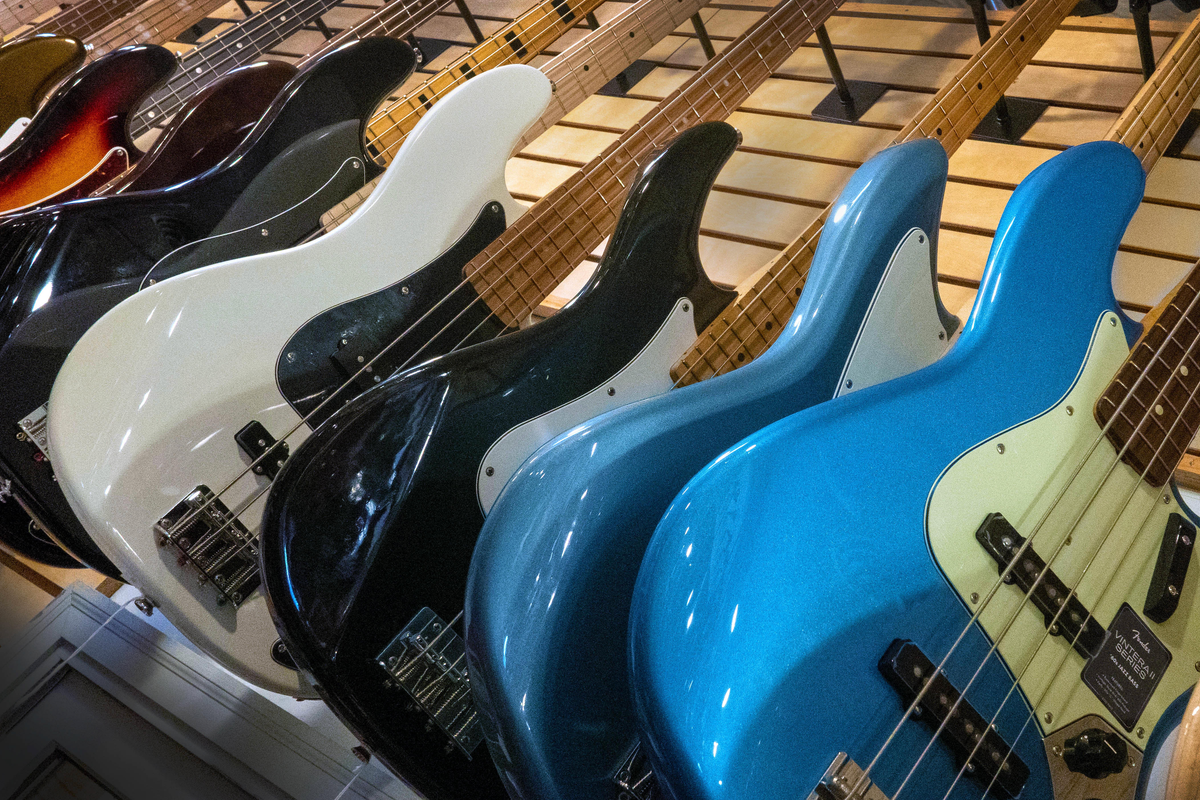
One of the most significant innovations in modern music is undeniably the electric bass guitar. There are conflicting opinions about who invented the idea and when, but it is without a shred of doubt that Fender brought it to the masses. Looking at the state of the instrument from where we are today it’s hard to believe there was a time when it didn’t exist. That alone tells you how important Fender’s contribution is. Sure, there are low notes on pianos, organs, and synths, but the utility and portability of the bass guitar beats these rivals by a mile. Despite all of this, the bass has often been treated like an afterthought.
Part of the reason might be that it’s easy for any guitarist to just pick one up and play it. After all, they’re tuned exactly like the lowest four strings of a guitar. In most cases, bass parts generally don’t require you to play those pesky and intimidating chords, and bendy dweedle-dweedle acrobatics are usually out of the question. All you have to do is stay in your lane and play the root and some passing tones. Throw in some octave jumps and you’re golden. Aside from the tambourine, it’s the simplest way to get into music. Or is it?
I first started playing guitar in a band with three guitarists and no bassist. We were all around 13 years old and had a very limited knowledge of what we were doing. Once we realized that most bands had a bass player, we pressured one of the guys to trade in his guitar—an all-white SG Junior—and get a bass. It made an immediate difference for the better.
One day at our weekly rehearsal, the bassist didn’t show up. As the lower-ranking guitarist, I was elected to strap on his Gibson EB-2 and carry on. With some disappointment, I plugged the bass into the bright-blue-and-brushed-aluminum Baldwin bass amp and plucked a note. I was thunderstruck. We launched into our first number as I attempted to navigate a slightly different, yet familiar highway. As I gained confidence, my attitude became gleeful. So much power underneath my fingers! Pretty soon I began to hope our bassist wouldn’t ever show up. As it turned out, the next week I was relegated back to playing those pesky chords on my 6-string, but the brute force and glory of the bass stuck with me. For decades it was my main instrument.
“Suddenly, bass tones I’d attributed to just the bass guitar were revealed to be multiple instruments.”
As a newly minted bassist I started paying more attention to bass parts on recordings and in live performances. I began to become more aware of how the bass worked with drums to form the foundation of the music I loved. When I listened to music I was familiar with, I suddenly heard things I’d missed for years. I was paying more attention to the way a rhythm section locked together, but I also heard how certain tones were created by the blending of percussion—mostly kick drum and toms with the bass. Suddenly, bass tones I’d attributed to just the bass guitar were revealed to be multiple instruments. This, of course, is because the drummer and bassist are listening to each other and weaving in and out of each other’s parts. I’d suggest that every guitarist or bassist take a crack at learning to play drums. Even a basic understanding of percussion will make you a better musician, producer, or recording technician. Hell, work on some keyboard chops while you’re at it. The more you appreciate different disciplines the better you’ll be, and you’ll enjoy music more, too. For a young musician, this was a revelation that put me on a path to appreciating different styles of music. That mindset has also spilled over into my work as an instrument builder. When you step outside of your chosen lane and see what creates the whole, you understand more about what’s important about music and instruments. As a guitarist this gives me a more holistic approach, too.
The list of truly masterful bassists that switched from guitar proves that playing the bass is not the demotion that some guitarists might say it is. Understanding the whole picture is the key. As it turns out, I was just another one of many guitarists who picked up the bass in unforeseen circumstances. Some of the best known guitarists-turned-bassists include Noel Redding, Paul McCartney, Tal Wilkenfeld, Walter Becker, Geezer Butler, and even one of the most prolific bassists in recording history, Carol Kaye. In this company, I’m happy to have accidentally become a bass player. For me, bass is not an afterthought—I regard myself as a reformed guitarist.
Monger Pedals Unveils Boiling Honey Optical Tremolo and Little Guy Fuzz/Phaser
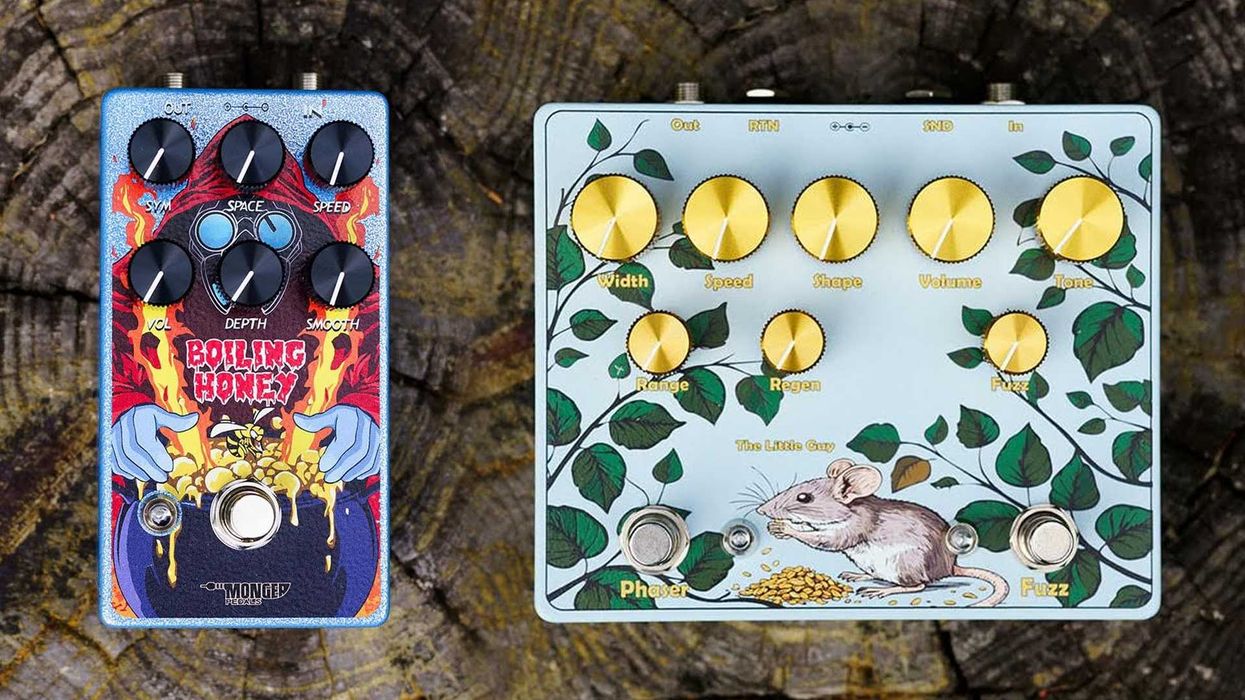
Adding to a lineup of versatile sound shaping guitar effects,boutique effects firebrand Monger Pedals has launched a pair of provocative new pedals: theBoiling Honey tremolo and Little Guy fuzz / phase shifter.
Boiling Honey
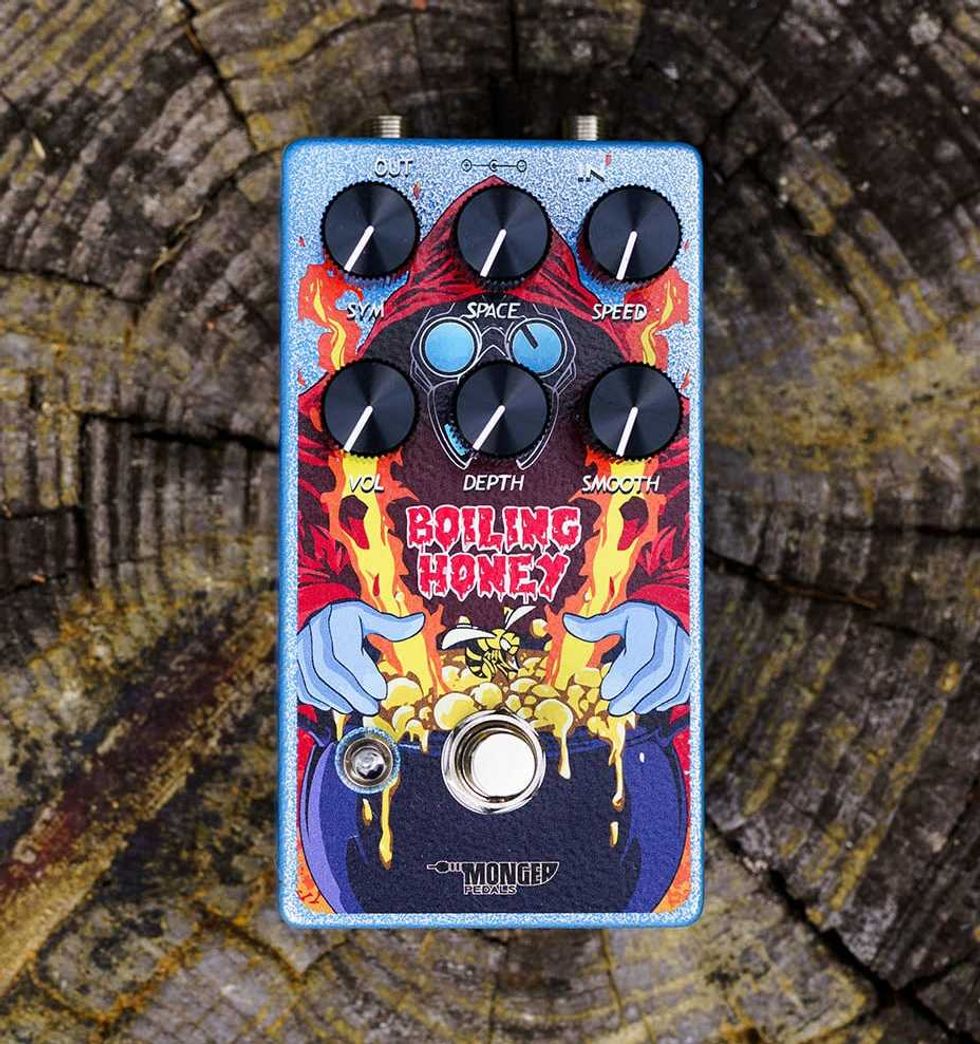
The Boiling Honey is an optical amplitude tremolo that delivers rich, pulsing modulation with a distinctly organic character. From smooth syrupy sways to sharp stuttering chops, it captures both warmth and bite in a single unit.
Boiling Honey features include:
- Analog optical amplitude tremolo
- 6 controls - Shape, Space, Speed, Volume, Depth, Smooth
- Rate LED shows what each control does internally
- True Bypass, Standard 9v operation, Top-mounted I/O
The Little Guy
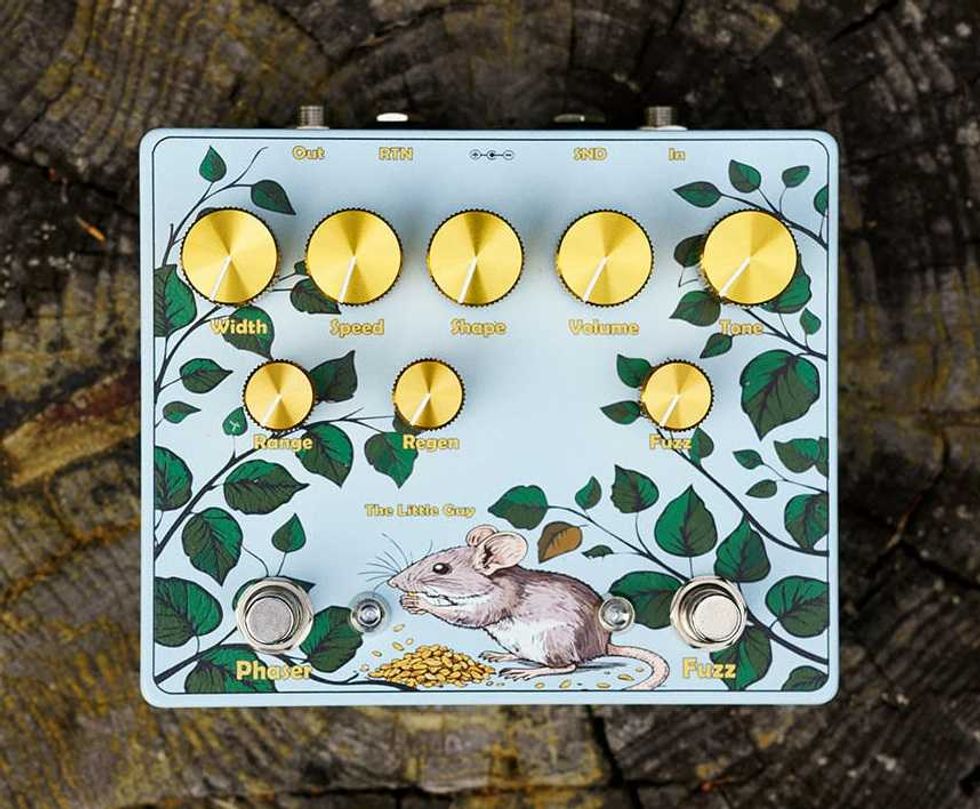
The Little Guy offers an extremely versatile two in one effect, combining fuzz and phase shifting into a single package designed to deliver a wide range of sounds. The phaser can shift frequencies and waveform shapes, while the fuzz keeps clarity and is extremely responsive to guitar input.
Little Guy features: include
- Fully analog modulation
- Two effects in one package with an internal signal chain from fuzz to phaser
- Send and Return input/output jack to break up the internal signal chain to allow for easy placement into your effect chain.
- Phaser controls for: Width, Speed, Shape, Range, Regen. Allows for infinite possibilities
- Fuzz controls for: Volume, Tone, Fuzz
- True bypass footswitches, 9-volt standard DC input, top mounted I/O
The Boiling Honey tremolo carries a street price of $145.00, and the Little Guy fuzz/phaser is priced at $224.99. Both pedals can be purchased directly from the Monger Pedals online store at www.MongerPedals.com.
Stompboxtober 2025: Xotic Effects
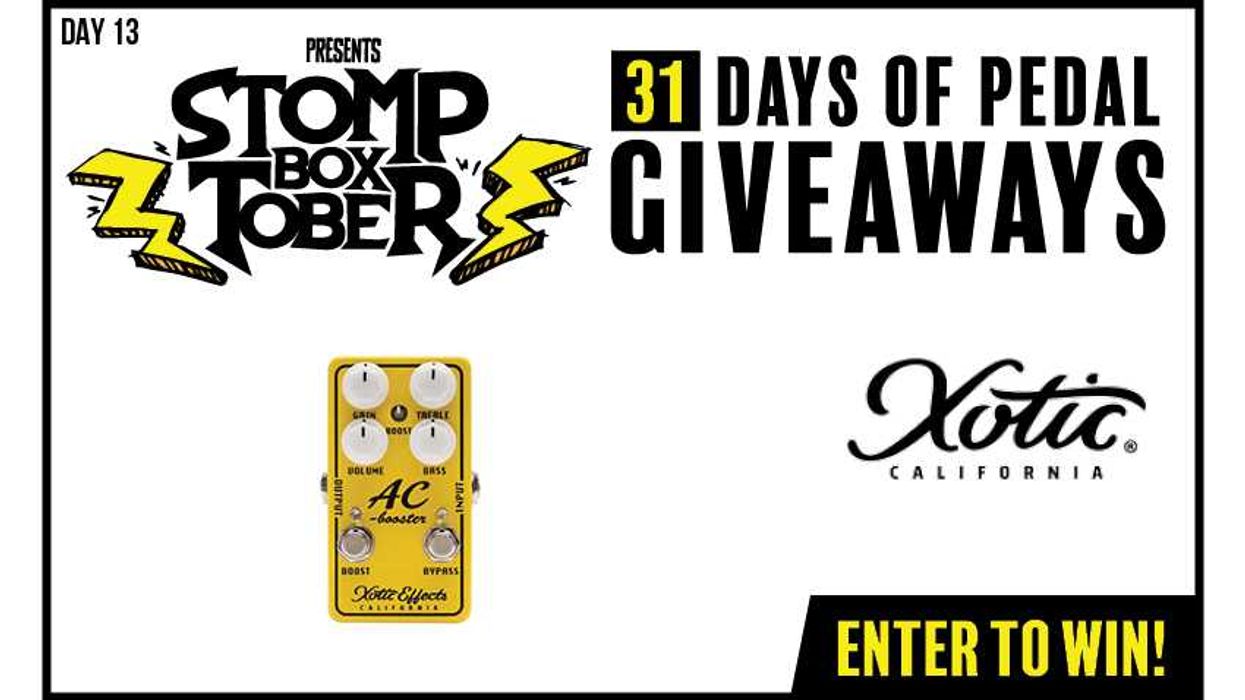
Turn up the tone! Enter today’s Stompboxtober giveaway to WIN the Xotic AC Booster V2 — responsive overdrive with touch sensitivity, classic warmth, and tonal shaping via dual EQ + DIP switches. Don’t forget to stomp back tomorrow for your next chance to score gear!
Stompboxtober 2025 - Win Pedals All Month Long!
Xotic Effects AC Booster V2
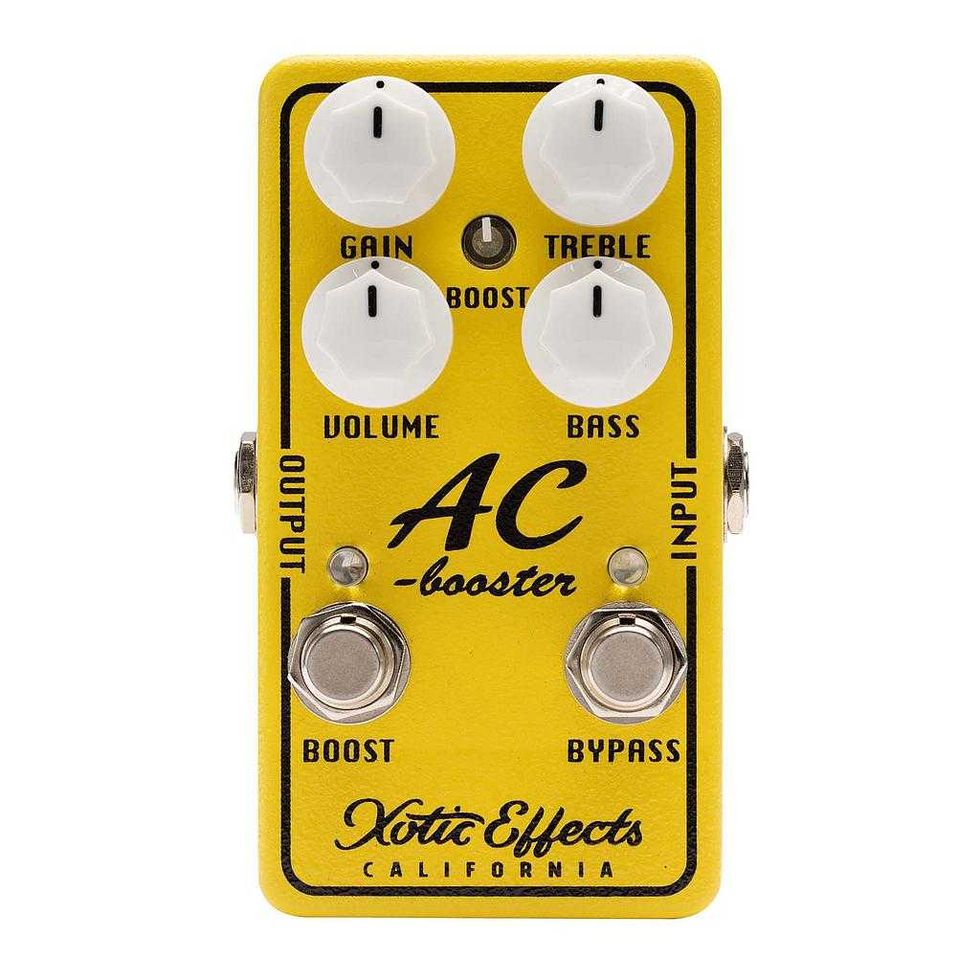
Reacting exactly like a great tube amp, the newly designed AC Booster V2 offers a wide range of overdrive with touch sensitivity just like the original AC Booster.
You can set it up to get a crunchy warm overdriven tone and with just a little rolling off of the guitar’s volume, it will give you a great clean sound.

Xotic AC Booster V2 Overdrive Pedal
Joe Walsh: The Classic Classic Rock Guitarist with Greg Koch | 100 Guitarists Podcast
When you think of classic rock guitar, what do you hear? Who is the most classic of all classic rock guitarists? We have a theory, and we tapped Greg Koch, the hard-touring, hard-rocking Gristlemaster himself, to join us and test it out. Is it Joe Walsh?
From his time with the James Gang through joining the Eagles and embarking on a successful, hit-laden solo career, Walsh epitomized the sound of ‘70s rock guitar riffs and solos. There’s a reason he eventually found his way to Ringo’s All-Starr Band! So is he the definition of classic rock?
Also, Greg takes this opportunity to chat about his Oasis obsession and shares his favorite Beach Boys song.

Learn More! www.gibson.com
Nembrini Audio Launches The Hughes & Kettner Tube Rotosphere Plugin
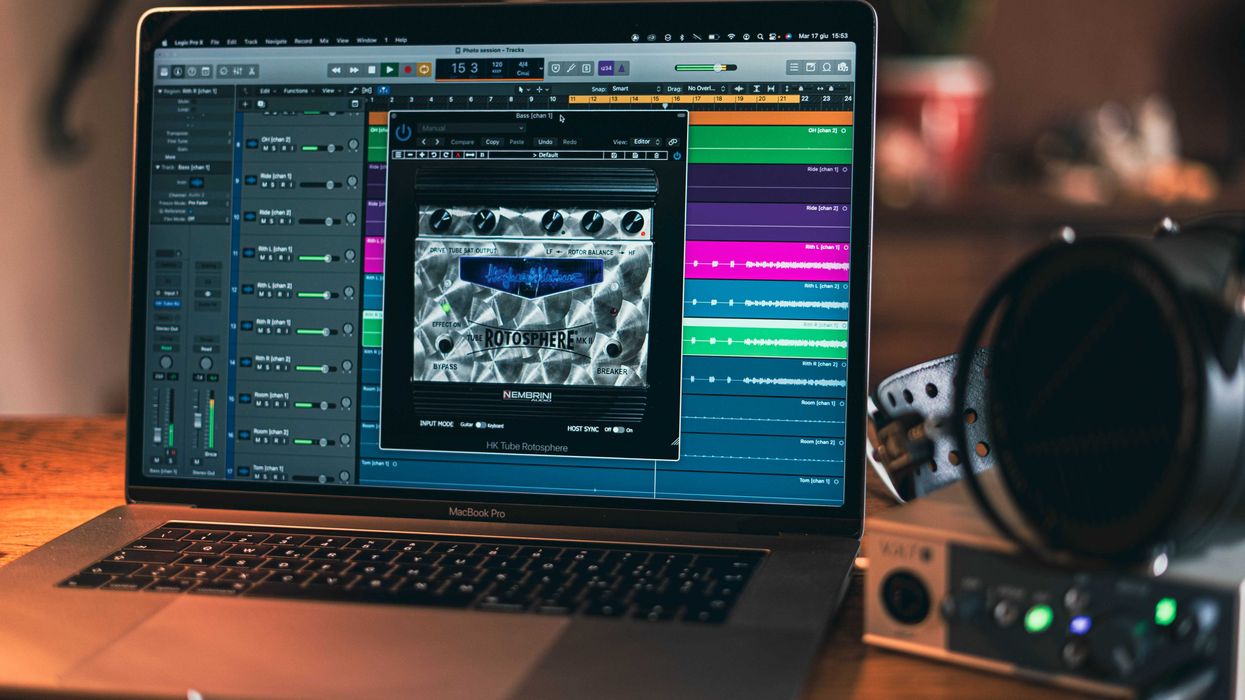
Nembrini Audio is pleased to launch the Hughes & Kettner Tube Rotosphere plugin, an authentic digital emulation of the acclaimed Hughes & Kettner Tube Rotosphere MKII Rotary Speaker* simulator. Listen to it here and see it here.
In the 1960’s the Leslie Speaker System*, originally developed in the 1930’s for the Hammond Organ, began to be used for guitars by The Beatles, Eric Clapton, David Gilmour and more. In the 1990’s Hughes & Kettner, a highly respected manufacturer of instrument amplifiers, cabinets and effect boxes, created the Tube Rotosphere pedal, an extremely accurate, analog reproduction of the Leslie Speaker System.
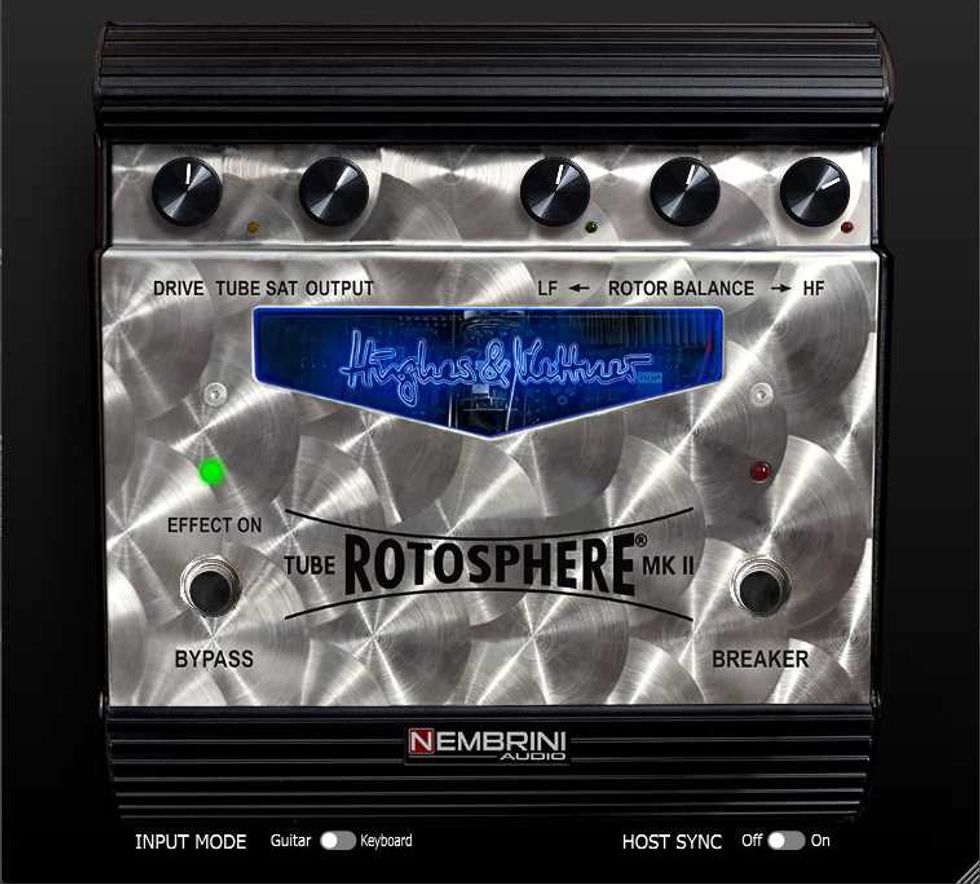
More than thirty years later, Nembrini ‘s new plugin breathes fresh life into this cool sound with the introduction of a realistic digital simulation of the much admired Hughes & Kettner Tube Rotosphere. Celebrated for its rich tube-driven character and highly musical rotary modulation, the original hardware was used keyboardists and guitarists seeking the iconic swirling depth of a classic rotary cabinet, with the warmth of real tube saturation. The new Hughes & Kettner Tube Rotosphere plugin faithfully captures every nuance of its analog counterpart, offering everything from subtle to dramatic Doppler-infused motion, with can be seamlessly integrated into any rig.
Nembrini’s advanced modelling technology captures all of the lush swirl, warm tube saturation and authentic rotary motion of the original pedal. The key features of the new plugin include true to life emulation of the analog circuitry and tube preamp behaviour, independent rotor speed simulation with separate LF and HF controls allowing precise adjustment and a breaker switch for realistic ramp-up/down and rotor stop effect. There is also tube saturation modelling with visual feedback, rotor balance control for fine tuning the blend and a stereo signal path for wide, immersive rotary modulation.
The Hughes & Kettner Rotosphere plugin desktop version is available at the introductory price of $29.99 (normally $99) until the October 31st 2025.
To find out more and download the Hughes & Kettner Rotosphere plugin please go to www.nembriniaudio.com/products/hughes-kettner-tube-rotosphere.
Stompboxtober 2025: Hotone
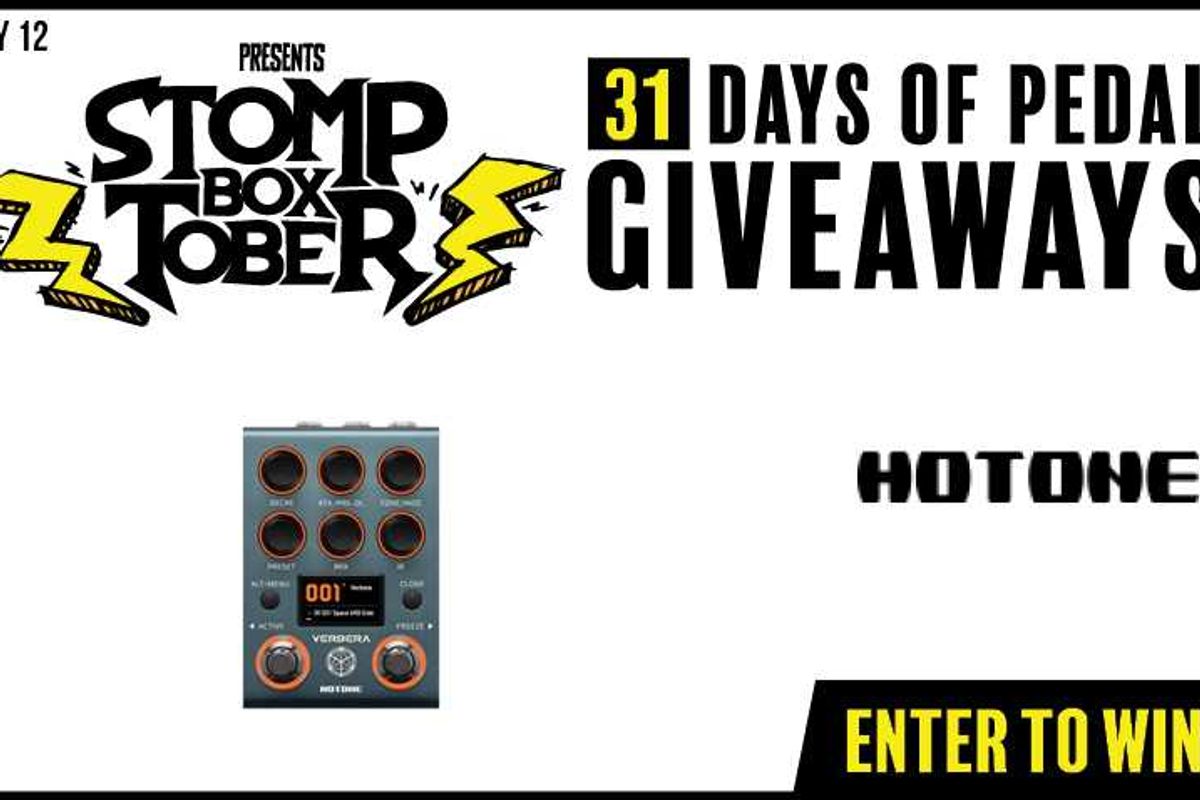
Don’t just echo—immerse. Enter today’s #Stompboxtober giveaway for a chance to WIN the Hotone Verbera convolution reverb — double engines, 120 built‑in IRs, stereo magic, and sonic depth to lose yourself in. Come back tomorrow for your next shot at gear you’ll love!
Stompboxtober 2025 - Win Pedals All Month Long!
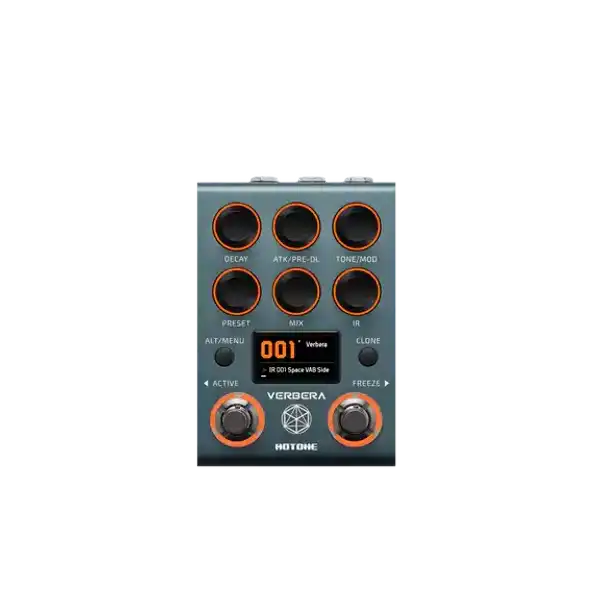
Ever imagined your sound echoing through a sold-out stadium? Or reverberating off the metallic walls of a NASA spacecraft hangar? What if your guitar fell into a cosmic white hole… or drifted through the vaulted ceilings of a centuries-old cathedral?
Welcome to Verbera — where imagination meets reality. This is not your typical software convolution plugin. Verbera is a standalone, hardware-based convolution reverb pedal — with Instant IR loading, stunning tweakability, and boundless sonic range. Whether you’re recreating iconic spaces, vintage hardware, or crafting otherworldly reverbs never heard before, Verbera gives musicians and engineers a powerful new tool for both live and studio setups.

Hotone Verbera Convolution Reverb Pedal
Neural NanOS 2.0.0 Review
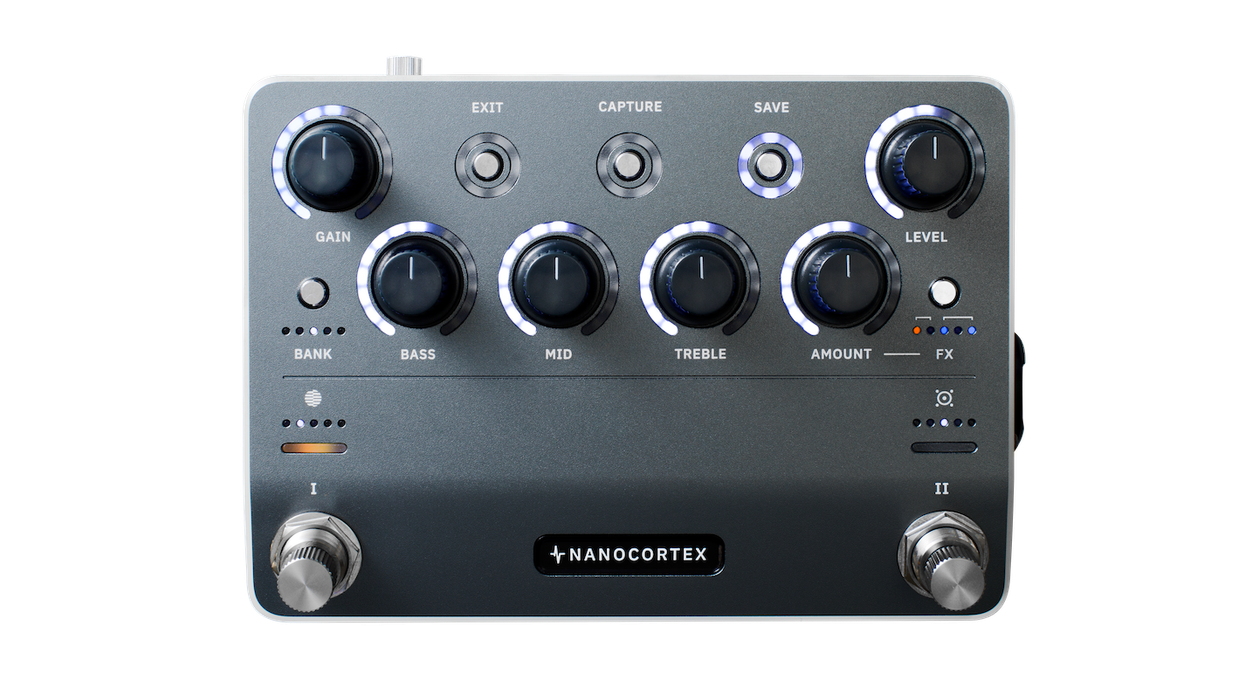
Neural DSP’s Nano Cortex for dyed-in-the-wool analog advocates new to the concept, is a whole rig—digital amp, cabinet simulator, effects unit, and capture device—in a box. It’s also a 24-bit, 48k Hz audio interface that can be powered by a laptop or power bank via USB-C. We reviewed the Nano Cortex upon its release in 2024. Like any new release, it left some hardcore users wanting for certain features. Some users found the effects roster underwhelming. There were also limitations about where you could situate effects relative to an amp capture. With a raft of new effects and greater flexibility, though, Neural’s 2.0.0 update addresses many concerns of power users and casual adopters alike.
Ever Evolving Technology
When the $549 Nano Cortex was released, it was a hit. The idea of a small, pocket-sized version of a Quad Cortex that weighs only 1.36 pounds—and at a third of the cost—had many guitarists drooling. But the truth is that while they are part of the same lineage, the Nano Cortex can’t match the flexibility of the Quad Cortex. This led to some confusion, and in some cases, unmet expectations.
The new, free NanOS 2.0.0 update addresses some of those letdowns with a much-expanded collection of 47 new effects—including dirt options, which, oddly, weren’t offered in the first OS version. (There is, however, only a single fuzz—a Fuzz Face emulation—which hints at the challenges of successfully modeling fuzz’s more chaotic nature.) There’s also an IR loader and global bypass to turn off IRs on all presets when you play the Nano Cortex through a real cabinet. The more customizable signal chain is also a very big deal.
The effects slots are more flexible, too. EQs and compressors can be set up in any slot—pre-or-post capture. Overdrive and wah effects can go into any pre-capture slots, while modulation, delay, and reverbs are assigned slots in the post-capture area. (The tape delay is warm, and a highlight.) Delay is only available in post-capture slot 2, before the reverb, which can only be slotted in post-capture 3 position. As you can see, NanOS 2.0.0 has opened up more possibilities, but limitations remain, especially for players that experiment with unorthodox setups.
Magic in the Clouds
Unlike the Quad Cortex, the Nano does not have a 7" touchscreen and the controls are very utilitarian. There are a few knobs and two hybrid footswitches/rotary knobs, but to really maximize the potential of the unit and manage your presets, you need to use Neural DSP’s Cortex Cloud app with your phone or tablet.
NanOS 2.0.0 has opened up more possibilities, but limitations remain—especially for players that experiment with unorthodox setups.The app makes things way easier, and using the Nano Cortex without it seems almost unimaginable. However, if your phone is the main interface, you can’t use your phone simultaneously for other common functions like filming videos at a gig or playing backing tracks. That said, the app lets you do a lot …once you get up and running. I can generally get around the basic functions of most multi-effects modeler-type systems, but being new to the Neural DSP ecosystem, it took me some time to get a workflow going. When I got it all figured out, the app made it very easy to instantaneously control parameters, maneuver complete signal chains, and capture pedals and amps.
Captivating Captures
Using the Nano Cortex, I easily captured the hi and lo channels of my Mesa/Boogie Flux Five, as well as the vintage, modern, and combined vintage-plus-modern modes of my Wampler Dual Fusion. I initially set up a lead sound with delay from my Yamaha UD Stomp situated after the Flux Five, but learned the hard way that a “capture” is a moment in time that cannot accommodate time-based effects.
Using a Shure SM57 mic, I captured the clean tones from my Ampeg SJ12-R and vintage black-panel Fender Deluxe combos. Each capture took about three minutes and nailed the sound. Impressively, the touch-sensitive qualities of the pedals and amp were present—I could dig in hard or play soft, and feel the Nano Cortex respond just like my Dual Fusion pedal and amps. One bummer about those clean Fender Deluxe sounds, though: The new effects in NanOS 2.0.0 do not include tremolo or spring reverb—a strange omission given how many vintage Fender amps fans exist among the Neural user community. That omission aside, I enjoyed the ethereal cave reverb effect and assigned it to one of my clean captures to satisfying effect.
In addition to allowing you to capture your own gear, the Nano Cortex also comes with many preloaded captures of amps like the Mesa/Boogie JP2C, Marshall Silver Jubilee, and Peavey 5150, among many others. There are also 10 IRs and two pre-and three post-FX blocks. And the Cortex Cloud app offers a ton of free presets, which have a complete chain of captures and effects from artists like Plini and Cory Wong.
The Verdict
I recently balked at using a favorite vintage ’60s Fender tube amp for a bar gig as visions of spilled beer filled my head. Instead, I used a pretty underwhelming solid-state alternative. But if I had had the Nano Cortex, I could have used captures of that vintage Fender, a few pedals, and put the whole setup in my gig bag. That part of the Nano Cortex experience remains a game changer. But as the incremental improvements in the NanOS 2.0.0 show, there is still ground to cover.
Neural NanOS 2.0.0 Review

Neural DSP’s Nano Cortex for dyed-in-the-wool analog advocates new to the concept, is a whole rig—digital amp, cabinet simulator, effects unit, and capture device—in a box. It’s also a 24-bit, 48k Hz audio interface that can be powered by a laptop or power bank via USB-C. We reviewed the Nano Cortex upon its release in 2024. Like any new release, it left some hardcore users wanting for certain features. Some users found the effects roster underwhelming. There were also limitations about where you could situate effects relative to an amp capture. With a raft of new effects and greater flexibility, though, Neural’s 2.0.0 update addresses many concerns of power users and casual adopters alike.
Ever Evolving Technology
When the $549 Nano Cortex was released, it was a hit. The idea of a small, pocket-sized version of a Quad Cortex that weighs only 1.36 pounds—and at a third of the cost—had many guitarists drooling. But the truth is that while they are part of the same lineage, the Nano Cortex can’t match the flexibility of the Quad Cortex. This led to some confusion, and in some cases, unmet expectations.
The new, free NanOS 2.0.0 update addresses some of those letdowns with a much-expanded collection of 47 new effects—including dirt options, which, oddly, weren’t offered in the first OS version. (There is, however, only a single fuzz—a Fuzz Face emulation—which hints at the challenges of successfully modeling fuzz’s more chaotic nature.) There’s also an IR loader and global bypass to turn off IRs on all presets when you play the Nano Cortex through a real cabinet. The more customizable signal chain is also a very big deal.
The effects slots are more flexible, too. EQs and compressors can be set up in any slot—pre-or-post capture. Overdrive and wah effects can go into any pre-capture slots, while modulation, delay, and reverbs are assigned slots in the post-capture area. (The tape delay is warm, and a highlight.) Delay is only available in post-capture slot 2, before the reverb, which can only be slotted in post-capture 3 position. As you can see, NanOS 2.0.0 has opened up more possibilities, but limitations remain, especially for players that experiment with unorthodox setups.
Magic in the Clouds
Unlike the Quad Cortex, the Nano does not have a 7" touchscreen and the controls are very utilitarian. There are a few knobs and two hybrid footswitches/rotary knobs, but to really maximize the potential of the unit and manage your presets, you need to use Neural DSP’s Cortex Cloud app with your phone or tablet.
NanOS 2.0.0 has opened up more possibilities, but limitations remain—especially for players that experiment with unorthodox setups.The app makes things way easier, and using the Nano Cortex without it seems almost unimaginable. However, if your phone is the main interface, you can’t use your phone simultaneously for other common functions like filming videos at a gig or playing backing tracks. That said, the app lets you do a lot …once you get up and running. I can generally get around the basic functions of most multi-effects modeler-type systems, but being new to the Neural DSP ecosystem, it took me some time to get a workflow going. When I got it all figured out, the app made it very easy to instantaneously control parameters, maneuver complete signal chains, and capture pedals and amps.
Captivating Captures
Using the Nano Cortex, I easily captured the hi and lo channels of my Mesa/Boogie Flux Five, as well as the vintage, modern, and combined vintage-plus-modern modes of my Wampler Dual Fusion. I initially set up a lead sound with delay from my Yamaha UD Stomp situated after the Flux Five, but learned the hard way that a “capture” is a moment in time that cannot accommodate time-based effects.
Using a Shure SM57 mic, I captured the clean tones from my Ampeg SJ12-R and vintage black-panel Fender Deluxe combos. Each capture took about three minutes and nailed the sound. Impressively, the touch-sensitive qualities of the pedals and amp were present—I could dig in hard or play soft, and feel the Nano Cortex respond just like my Dual Fusion pedal and amps. One bummer about those clean Fender Deluxe sounds, though: The new effects in NanOS 2.0.0 do not include tremolo or spring reverb—a strange omission given how many vintage Fender amps fans exist among the Neural user community. That omission aside, I enjoyed the ethereal cave reverb effect and assigned it to one of my clean captures to satisfying effect.
In addition to allowing you to capture your own gear, the Nano Cortex also comes with many preloaded captures of amps like the Mesa/Boogie JP2C, Marshall Silver Jubilee, and Peavey 5150, among many others. There are also 10 IRs and two pre-and three post-FX blocks. And the Cortex Cloud app offers a ton of free presets, which have a complete chain of captures and effects from artists like Plini and Cory Wong.
The Verdict
I recently balked at using a favorite vintage ’60s Fender tube amp for a bar gig as visions of spilled beer filled my head. Instead, I used a pretty underwhelming solid-state alternative. But if I had had the Nano Cortex, I could have used captures of that vintage Fender, a few pedals, and put the whole setup in my gig bag. That part of the Nano Cortex experience remains a game changer. But as the incremental improvements in the NanOS 2.0.0 show, there is still ground to cover.
Stompboxtober 2025: Ernie Ball
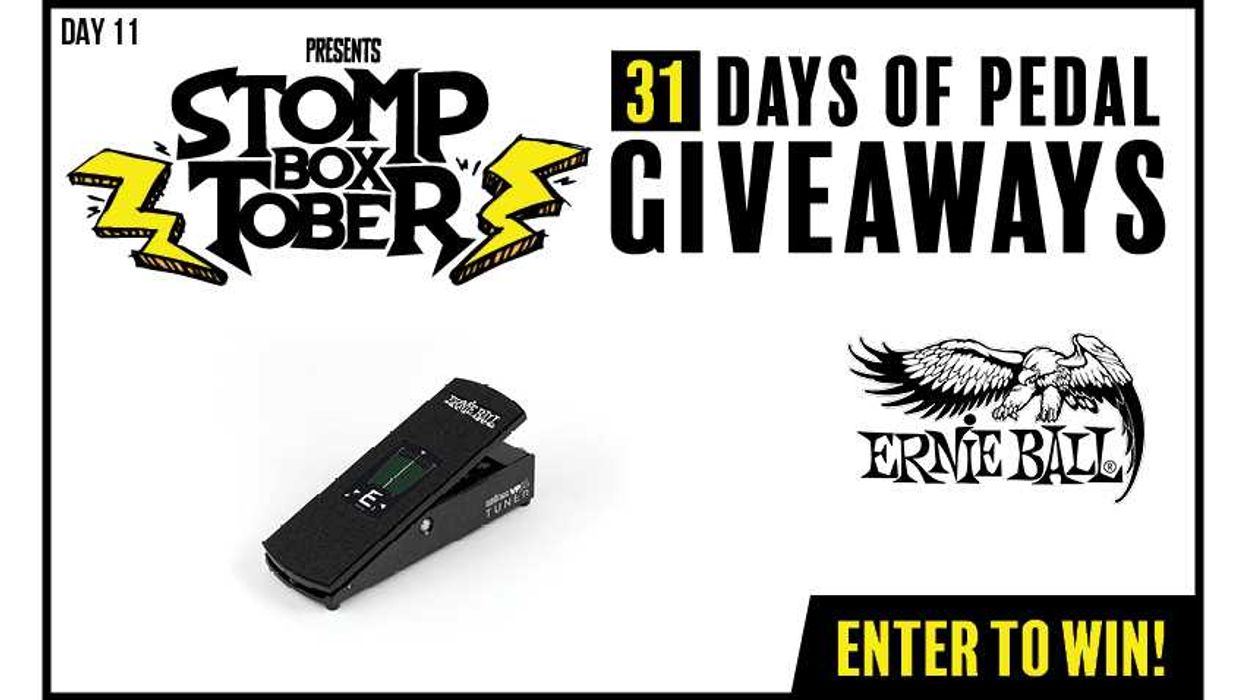
Tune and control in one sweep! Enter today’s Stompboxtober giveaway for your chance to WIN the Ernie Ball VP Jr. Tuner/Volume Pedal — get silent tuning, full volume control, and sleek efficiency all in one pedal. Don’t forget to come back tomorrow for another stellar giveaway!
Stompboxtober 2025 - Win Pedals All Month Long!
Ernie Ball VPJR Tuner Pedal
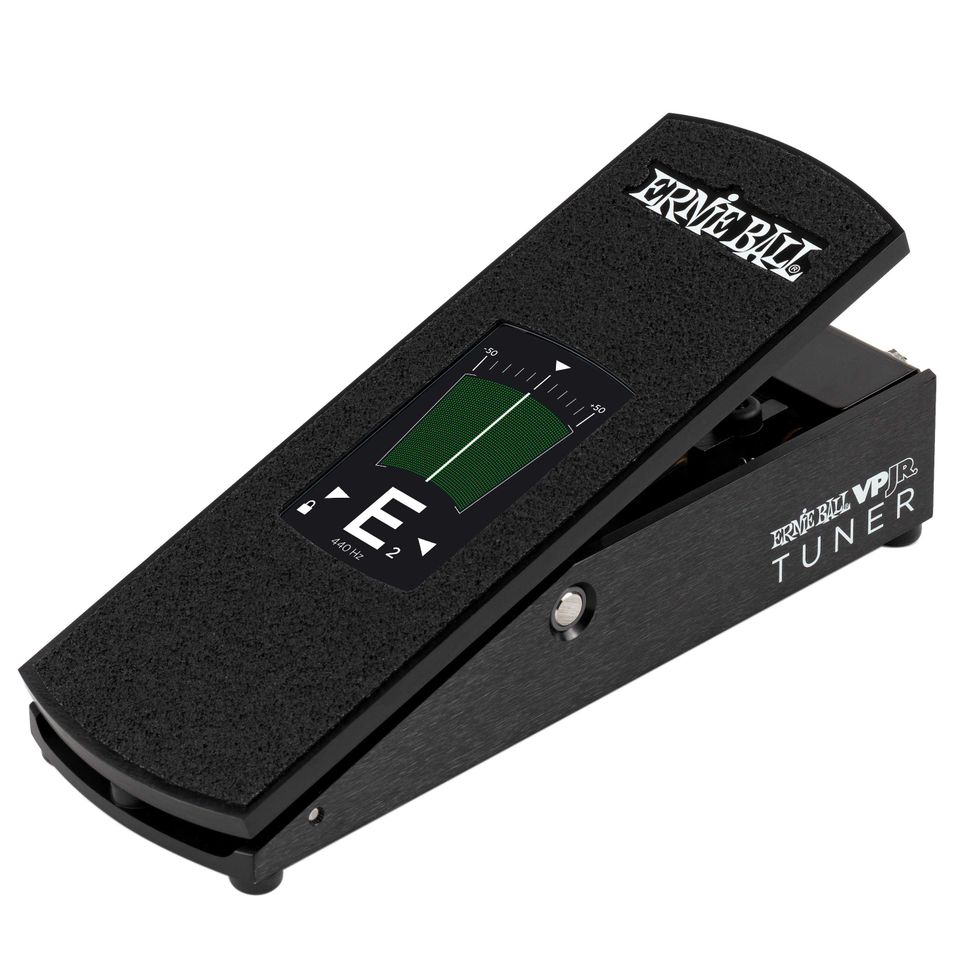
The VPJR Tuner pedal combines Ernie Ball’s world-renowned volume pedal with an enhanced definition digital guitar tuner. In the heel-down position, the pedal’s vibrant touchscreen automatically enters tuner mode, allowing for silent tuning. As the foot sweeps forward, the screen switches to volume mode, providing a graphic display of your volume level. Alternatively, the screen can remain in volume mode or tuner mode, regardless of the pedal’s position in the sweep. Simply double tap on the touchscreen to toggle between modes. The VPJR Tuner provides the same rugged construction and time-tested performance as Ernie Ball’s traditional volume pedal.
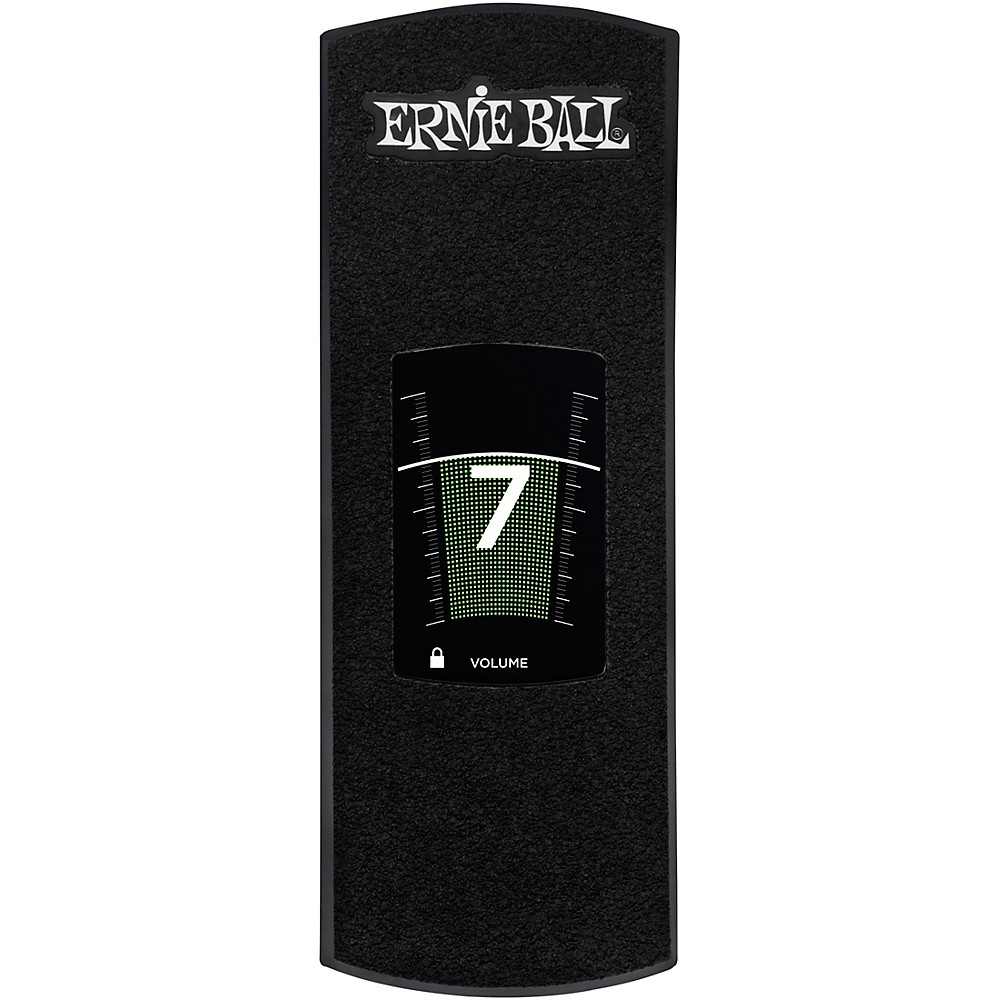
Ernie Ball VPJR Tuner Volume Pedal Black
Willie Nelson and the Lost Art of Relentless Creation
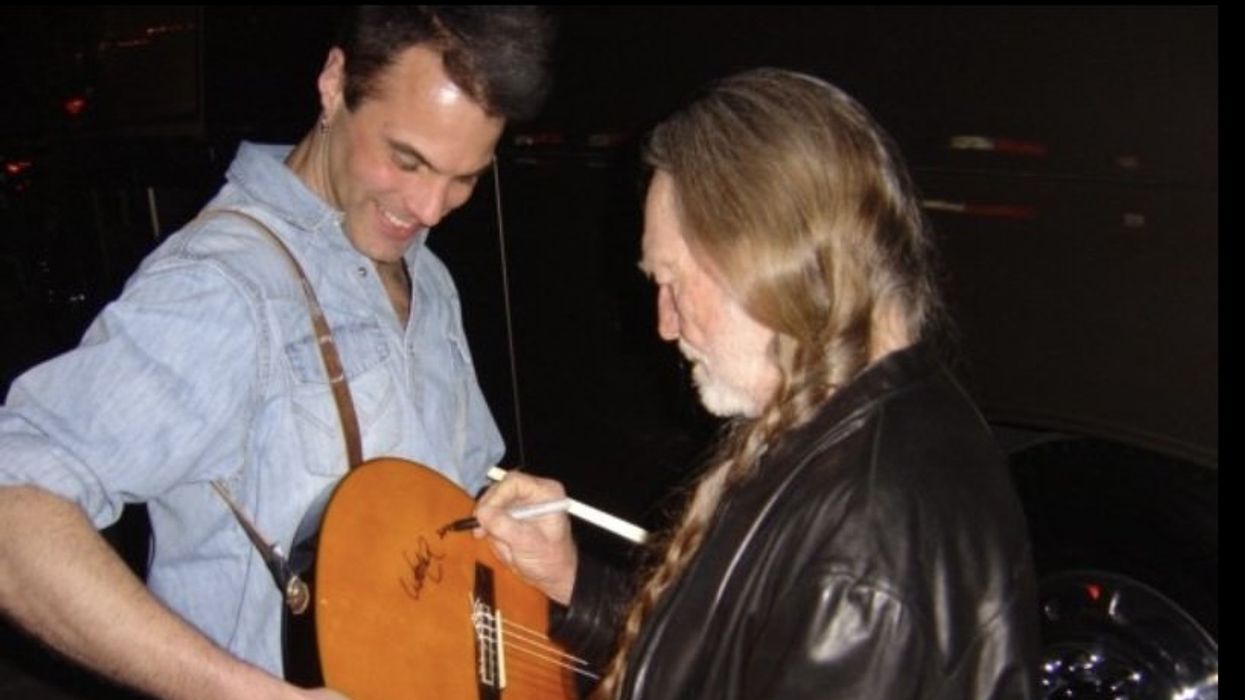
Over the years, I’ve done two TV shows with Willie Nelson—Nashville Star in 2004, and a CMA award show a few years later. On TV sets, there’s a lot of standing-around time while producers fiddle with lights and other details. What struck me both times was that whenever the action stopped, Willie did not stand around: He’d get on the ground and rip out a bunch of pushups. No wonder that today, at 92, Willie Nelson is still out there, braids swinging and beating Trigger, his Martin N-20 he bought new in 1969, like it owes him money. Willie and that guitar have both ridden some hard miles that have left them a bit threadbare, but to my ears, their voices are a bit warmer, softer, and darker for it—like weathered tapestry. You have to marvel at his endurance. In an era where artists tour sparingly and drop albums like rare comets, Willie Nelson is a throwback to a time when musicians lived to play and create, night after night, record after record.
Willie’s numbers tell the story. Since his debut album, …And Then I Wrote, in 1962, he’s released 153 albums—76 solo studio records, 26 collaborations, 14 live albums, 51 compilations, and soundtracks like The Electric Horseman and Honeysuckle Rose. That’s roughly 2.5 albums per year over 62 years. His latest, 2024’s Last Leaf on the Tree, proves he’s still got something to say. Compare that to today’s artists: Many release an album every two to three years, often with heavy promotion and long breaks. Billie Eilish, a generational talent, has three albums since 2019. Taylor Swift, a prolific outlier, has averaged roughly one album per year since 2006. Willie’s output dwarfs them all.
Then there’s the road. Estimating Willie’s live shows is like counting stars, but conservative math suggests he’s played 4,700 to 10,000 gigs since the 1950s. In his peak decades (1960s–2010s), he averaged 50–100 shows annually, from honky-tonks with Ray Price to headlining Farm Aid, which he co-founded in 1985. A 2018 Rolling Stone piece noted that even at 85 he was still clocking 100 dates a year. That same year, his harmonica player, Mickey Raphael, claimed to have played over 5,400 shows with Willie since 1973. Today’s artists? Many cap tours at 20–50 dates, citing burnout or “self-care.” The contrast is stark: Willie’s work ethic is a relic of a bygone era.
Why the difference? Part of it is cultural. In Willie’s day, musicians survived on gigs and records, not streams or brand deals. The 1960s and ’70s demanded constant output—labels expected albums, fans expected shows. Willie, Waylon, and the Outlaw crew thrived in that grind, playing dives and arenas alike. Today, streaming platforms prioritize singles over albums, and social media rewards viral moments over sustained creation. Artists can tour less and still profit through merch and sync deals. Willie’s era had no such shortcuts.
But it’s not just economics. Willie’s drive feels existential. Born in 1933, he’s outlived the male life expectancy of his time (59.1 years) and today’s (74.8 years). Despite early years of heavy smoking and drinking—traded for marijuana in 1978—Willie’s still here, defying odds. I suspect it’s because he has to create. Music isn’t just his job; it’s his oxygen. Compare that to modern artists who pause careers for side hustles or other non-musical reasons. There’s wisdom in balance, but Willie’s relentless output suggests purpose fuels longevity.
He’s got things to do, but he never seems rushed … he’s just always moving. Like his 1993 song says: “Still is still moving to me / I swim like a fish in the sea all the time / But if that’s what it takes to be free, I don’t mind / Still is still moving to me / Still is still moving to me.”
Willie cut his classic 1975 record, Red Headed Stranger, in a week, and on a shoestring budget. It’s not a polished effort, but it carries a lived-in authenticity, each track a snapshot of a moment. Today’s overproduced tracks can feel like products, not stories. Stranger feels like Willie is an old friend sitting in your living room, singing his story.
What can we learn from Willie? For musicians, it’s a reminder that creation is a muscle—use it or lose it. The road, the studio, the stage … these are where songs are born, not in boardrooms or Instagram reels. Willie’s not chasing trends; he’s chasing truth. His 153 albums aren’t all masterpieces, but they’re all him. Modern artists could take a cue: make more, fear less. Quantity breeds quality when you’re unafraid to fail.
Willie has had plenty of tragedy and struggle, but one of his superpowers is his ability to let go of worry and lean into the good in life. As he has said, “Worry will make you sick. I’ve never seen it accomplish anything. I’ve never seen worrying about something change it, so I decided not to do it. Every negative thought you have releases poison into your system … so if you’re thinking negatively about something, erase that.”
In a world of fleeting hits and curated personas, he’s a beacon of what it means to live for the music. Maybe that’s why he’s still here, outlasting time itself.
Finding Dissonance in Tonality
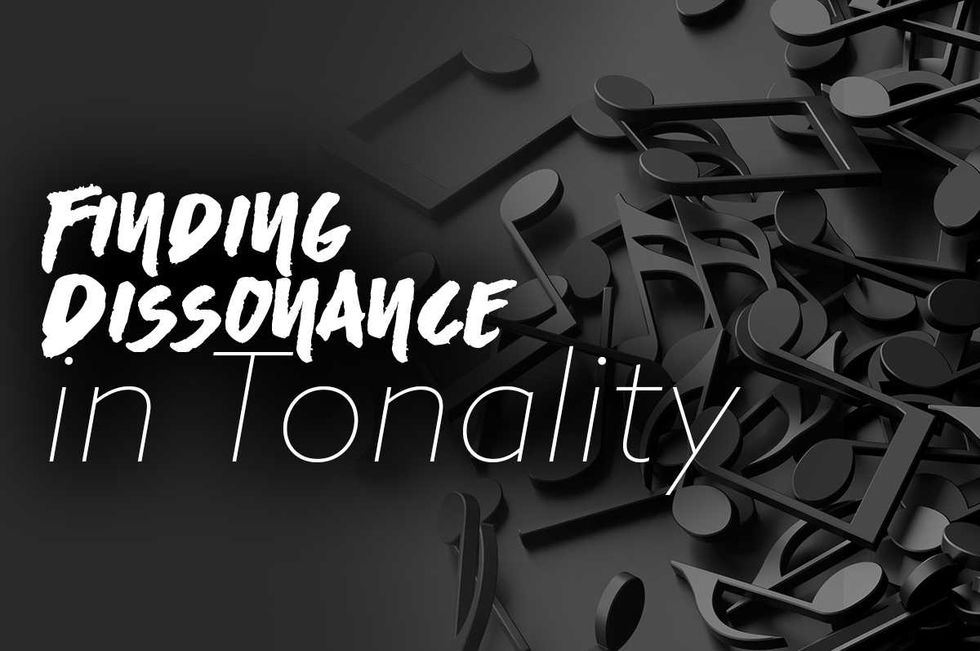
This is a lesson in what I call “finding dissonance in tonality.” The goal here is to focus on creating arpeggiated chord shapes and riffs that use tense intervals like 2nds, tritones, and 7ths, while still remaining in a particular key signature. This creates a haunting and moody sound that I often like to think of as “pretty dissonance.” In these examples we will find progressions that are dissonant yet still diatonic. It is a sound I use quite often in my own music and one that my ears are naturally drawn to.
Ex. 1
Ex. 1 demonstrates this concept by picking a key—in this case A minor. Then, I decide on a modal sound in that key (D Dorian). Next, we construct chord shapes in that key to include things like stacks of 2nds, or tritones mixed with 2nds. We have to look at our key signature and find which notes give us 2nds, tritones and 7ths. In this case, the notes we want to utilize are B and C, and E and F for our minor 2nds (or major 7ths depending on which note is in the bass). We’ll use A and B, D and E, and G and A for our major 2nds, and F and B for our tritones.
You might find that this example has a pleasing sound, despite the dissonance, since Dorian has a dreamy and nostalgic feeling to it. Yet the particular mix of intervals gives it a certain tension. The stretches here can be challenging, and there is a bit of movement around the neck. This example sounds best when played with a clean sound with all the notes ringing out together. We also have some time signature changes to keep us paying attention as well.
Ex. 2
For Ex. 2, we’re in the key of G major and are focusing on using a combination of 2nds, tritones, and 7ths to create some lush modal chords. The tension in these chords in particular is created by the G root note of chord one ringing against the F# on the D string, creating a major 7th. Then, we have that same F# hitting a C to create a tritone. Finally, the C to open B string at the top is creating a minor 2nd. Chord two has the major 7th again with the low C to B, then we have a major 2nd with the E to F#, and at the top of the chord, that same F# against the open E, creating another major 2nd. The final chord uses tritones again with the F# to C and then up to F# again. The top of the chord has an A to open B creating a major 2nd. This is a good example of how to create uplifting, major-key progressions that have a little spice to them.
Ex. 3
Ex. 3 takes the same chords of Ex. 2 but “octave displaces” certain notes to create wider spread voicings. The note relationships are still the same, it’s just that some notes have now been placed an octave higher throughout the progression. This makes it a bit more challenging to play, so I’ve taken the bpm down a bit. In general, I recommend practicing these very slowly at first and aiming for clarity and articulation. Utilizing the approach of octave displacing can create some very interesting melodic sequences. It is a fantastic way of creating a variation out of something you’ve already written.
So far these examples have been fairly light and bright sounding despite the dissonance in the chords. Ex. 4 gets a little darker and more tense. It’s also in 5/4 time. Based in the key of D minor, this riff heavily focuses on using minor 2nds. First, I look at the key signature, which has one flat: Bb. Next, I find which notes in the D minor scale give me minor 2nds. These notes are A to Bb and E to F. Bb to E also gives me a tritone. Once again, there is a bit of movement all around the neck in a short amount of time.
Ex. 5
Ex. 5 is again in D minor but more of a lower-register riff. In this example, I also use a somewhat tense interval we haven’t talked about yet, the minor 6th. In the first three notes of the example, we have a D to an A. Nothing tense there, just a perfect 5th. Next, though, is an A to a Bb—a minor 2nd. In addition, the relationship between notes one and three is a minor 6th. This interval appears again as the last dyad in the first bar. Those first three notes (D, A, and Bb) give us a sus b6 chord shape. I first came across this chord in the song “Guardian” by Fates Warning. Their guitarist Jim Matheos uses a lot of these haunting interval combinations, which became an influence on me early on in my playing.
Ex. 6
I encourage you to find some chords and progressions of your own that take inspiration from this approach. I’ll leave you with Ex. 6, a simple way to start. Take some basic major and minor chord shapes and add extensions to them like 2nds, 4ths, 6ths, etc. Chord one is an Am(add9), which is the 2nd moved up an octave. Chord two is a Cmaj(add#4). Chord three is a Bm(add11/b9). Chord four can be thought of as an inversion of Cmaj(add#4). The E in the bass makes it sound very dark. Those new scale tones create extra tension and dissonance and automatically make what you’re playing sound more evocative. Try these ideas out and see what paths they take you down!
Meet the Brands Powering the DIY Guitar Revolution
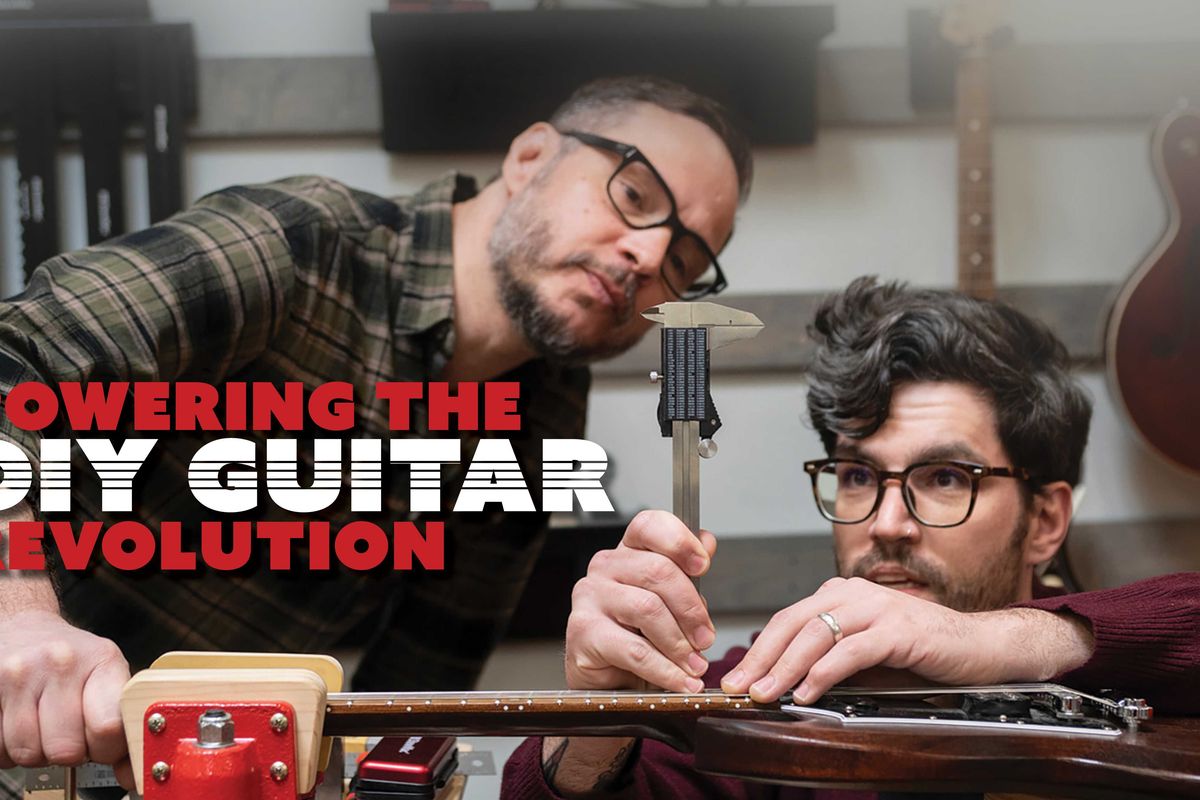
If you like to make, mod, or mess with your instrument, chances are you’re familiar with StewMac and Allparts. Here, their people tell us how they became the go-to suppliers for DIYers around the world.
It’s easy to forget, but it takes all manner of materials, tools, and know-how to make and maintain a well-loved guitar that’s built to last and plays exactly the way you like it. Pickups, tone knobs, toggle switches, and input jacks. Neck plates, bridges, tailpieces, and saddles. Strap buttons, truss rods, pickguards, string retainers, tuning keys, fret wire, ferrules. Capacitors and circuitry, nuts, and washers, screws and springs. Not to mention the tonewoods and specialized luthier tools used to fashion the body, neck, headstock, and fretboard.
These days, it’s not hard to find the parts and tools that guitarists need to make, repair, or upgrade their instrument. But decades ago, it wasn’t so simple. Before the days of online forums and same-day shipping, guitarists, luthiers, repair techs, and shopkeepers often had to scour the earth for the specific part they were looking for, or make do with an imperfect replacement.
Into that flawed and frustrating market stepped a few enterprising enthusiasts determined to streamline that search for the perfect part. The idea was simple: What if we just sold all of it? Every knick-knack and doodad, all in one place?
In the process, StewMac and Allparts emerged as the leading suppliers of guitar parts and tools, making it possible for nearly anyone to pursue their own quest for the perfect tone.
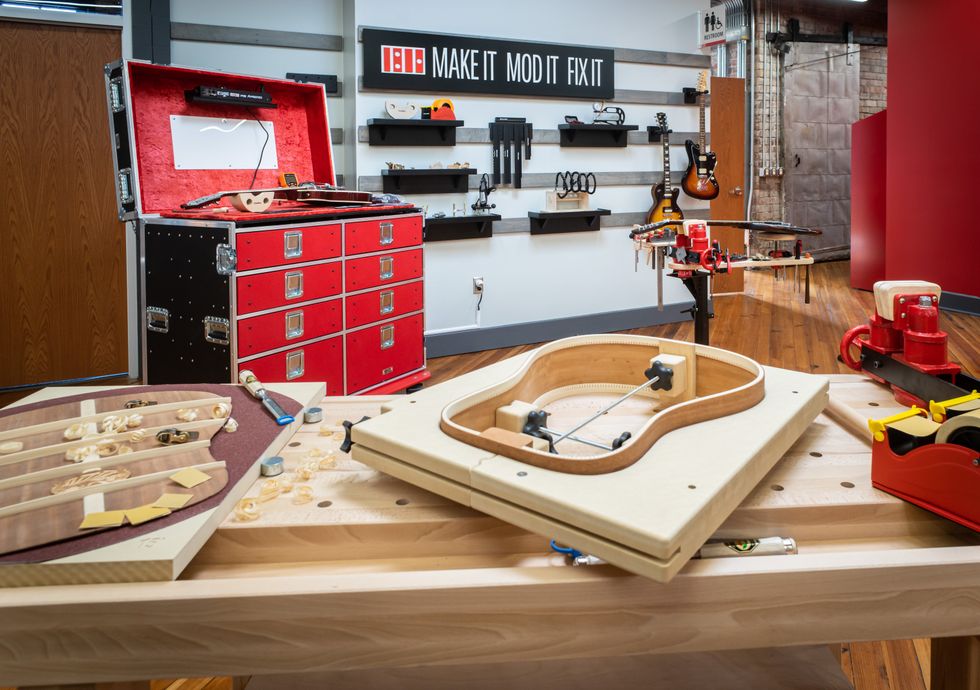
Leading a Community of Luthiers
StewMac’s motto is “making guitars better.” But in the beginning, the brand had almost nothing to do with guitars.
In 1968, Kix Stewart walked into a music store in Athens, Ohio, to repair his banjo. He became friends with the owner, Bill MacDonald, and the two started building their own banjos. Not satisfied with the banjo heads available on the market, they developed their own. Soon, they realized they were making more money selling the individual parts than they were from the banjos themselves. So, Stewart and MacDonald focused on the parts, expanding their business with banjo assembly kits and mandolin components.
The biggest evolution yet came in 1986 with the addition of Dan Erlewine, now one of the most well-known names in lutherie and guitar repair. The company began not only selling guitar parts, but also developing their own specialty tools. Today, the company now known as StewMac is one of the world’s foremost suppliers of tools, parts, and woods for stringed instruments.
Still headquartered in Athens, a small city about 75 miles southeast of Columbus, the company employs just over 100 people at its four-story, 60,000-square-foot warehouse, which houses an inventory of more than 7,000 different products. About 15 percent of that is made, assembled, or modified at StewMac’s facility, while the rest is sourced from third-party suppliers. Elsewhere, StewMac runs their European distribution through the Spanish luthier company Madiner, which carries StewMac products and sources many of the tonewoods they sell.
On the average day, StewMac will ship out at least 800 orders, and during especially busy times—the holiday season, for instance—they can see up to 2,000 orders each day. A team of two dozen pickers works on the warehouse floor, shipping out orders within hours of when they’re received.
“Everybody that works here plays guitar, repairs guitars, builds guitars. It’s not so much a job as it is a calling.”—Brock Poling
As Brock Poling, StewMac’s vice president of marketing, explains, the company has succeeded largely because of its passion for the craft. Poling is a luthier himself, and he was a StewMac customer before he joined the team in the early 2000s.
“We’re not just a company that’s selling you stuff,” says Poling. “Everybody that works here plays guitar, repairs guitars, builds guitars. It’s not so much a job as it is a calling.”
There are several reasons why StewMac has managed to grow from a two-man operation into an international enterprise that’s been in the business for 57 years.
One important factor is their focus on specialty tools. Some of the company’s bestselling products include fretting tools and bending machines that were developed in-house by expert luthiers. This year, two of the hottest products have been the J Edwards Fractal Fret Press, handcrafted by Texas-based luthier Jerame Edwards, and a new acoustic guitar side bending system, designed in-house with input from Charles Fox, the original inventor of the universal side bender.

Among StewMac’s other bestsellers are all-in-one kits that come with everything a beginner needs to complete their own project. The company introduced its acoustic and electric guitar kits in 2017, and a few years later expanded to offer a line of pedal kits, including the highly popular Ghost Drive, a do-it-yourself clone of the Klon Centaur.
“We’ll have people sending pictures of amp kits they’re working on, asking, ‘Where did I go wrong?’ And we’ll help troubleshoot.”—Ally Campbell
But what has really made the difference in the company’s business model, Poling says, is its strategic focus on how-to guides and video tutorials. StewMac has nearly half a million subscribers to its YouTube channel, which offers more than 500 videos about building, repairing, and maintaining guitars.
“This opens a new avenue to give someone a new idea, a new project, a new thing to pursue,” says Poling. “I’ve built our pedal kits. That is a new thing for me. I’ve never really built anything like that before. It’s fun, because not only is it a new project, it’s also a new set of skills.”
In essence, StewMac has fostered a community of users who are regularly looking for ideas for their next project—and conveniently, StewMac has all the parts and tools to bring those projects to life.
“We’ve really tried to look at this as if we are YouTubers first and a brand second,” says Poling. “We don’t sell, we don’t pitch. We want to provide value to the people that are watching these videos. The tools and materials that are in our videos are just cast members in the story.”
Poling says that while a small percentage of the company’s customers are professional builders, the majority are hobbyists. In 2020, when Covid pandemic forced most people to stay at home, StewMac saw an “enormous lift” in sales, Poling says.
There are about 30,000 subscribers to the StewMAX membership, which offers free shipping and returns, discounts, and monthly offers. And if anyone runs into problems, StewMac has plenty of people around to help.
“We don’t just have customer support reps to help with orders—we also have a team of guitar techs who can walk you through projects,” says Ally Campbell, StewMac’s social media manager. “We’ll have people sending pictures of amp kits they’re working on, asking, ‘Where did I go wrong?’ And we’ll help troubleshoot.”
StewMac has tapped into a community constantly on the lookout for the next invention to make guitar work faster, easier, better—or all of the above. That’s also where Allparts shines.
“Recession-Proof”: The Timeless Appeal of DIY
While StewMac was still in its early years peddling banjos, the manager of a music store in Houston had his own idea for a company that would sell the guitar parts he had always had such a hard time finding.
In 1982, Steve Wark started Allparts in his garage, working several part-time jobs to take care of his new family while he cold-called music stores across the country to sell his catalog of 115 hard-to-find products he had sourced from a single Japanese supplier.
“You can’t necessarily count on another Eddie Van Halen and Floyd Rose combination coming along. So, we have to think as players: What would be interesting?”—Dean Herman
Throughout the ’80s, Allparts benefitted from strong sales of metal parts, particularly a bestselling tremolo that was marketed as an alternative to the Floyd Rose, just as that product exploded in popularity thanks to shredders like Eddie Van Halen, Joe Satriani, and Steve Vai.
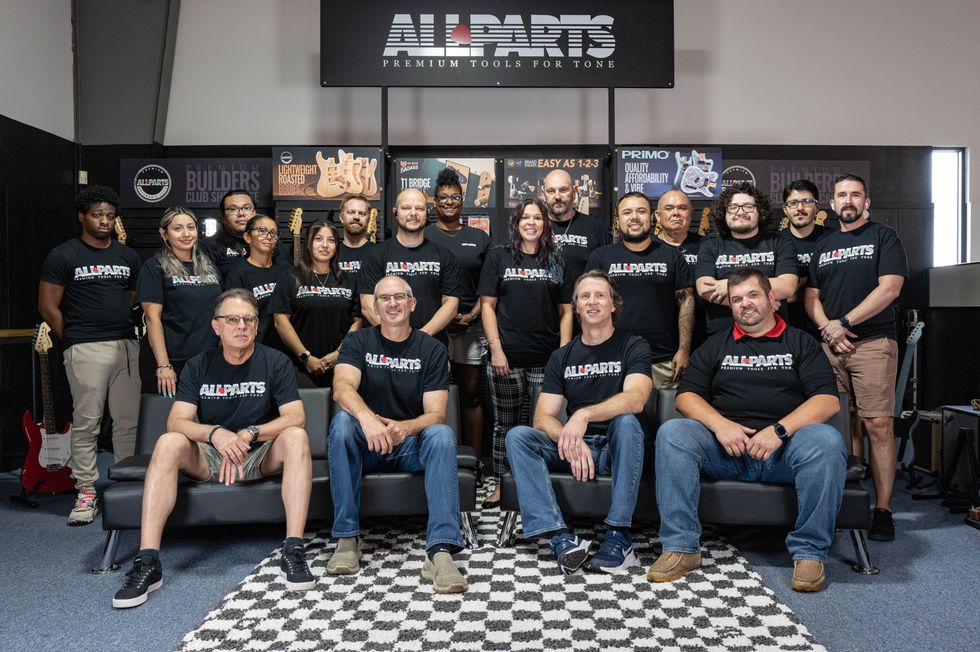
Nowadays, Allparts sells more than 3,500 items from suppliers in 18 countries, and it fulfills thousands of orders per month. Far removed from Wark’s garage operation, Allparts employs roughly two dozen people at its 13,000-square-foot facility in Houston.
“The company has always been fairly lean. “Everybody here wears a couple of hats,” says Allparts president Dean Herman. “We’re very capable of being able to adapt to whatever the business calls for.”
By 2020, Wark had sold Allparts to the private equity firm Ambina Partners and was planning his retirement. Herman joined the company after 25 years at Fender, where he had worked his way up from junior rep to sales director. First hired as Allparts’ vice president of sales and marketing before being promoted to president a few years later, he was tasked right away with modernizing the company’s e-commerce site, sales and inventory system, and order fulfillment.
Five years later, he reports that results have been positive across the board: a boost in sales, improved logistical efficiency, and a superior customer experience. The company now keeps pricing and inventory more accurate, ships most web orders the same day, and has strengthened its product descriptions to help customers understand each piece of gear and why it could be the right fit for their rig.
Allparts receives a lot of high-volume, lower-priced orders for small, highly specific parts with “evergreen demand,” like jacks, switches, pots, and knobs. But their real bestsellers are the premium, player-oriented aftermarket upgrades, like Leo Quan’s Badass bridges and tuning keys, and the relatively new Certano T-Bender bridge for Telecasters.
Herman is particularly proud of the T-Bender, which was designed by the French craftsman David Certano and further developed in partnership with Allparts. The bridge serves as a simplified alternative to B-Bender and G-Bender bridges, offering players the ability to bend their B or G string up to a full step to get those classic pedal steel sounds. But unlike its predecessors, it doesn’t require any extra drilling or routing to install, and is fully reversible. That makes it way more accessible to players curious to try it out, but who don’t necessarily want to spend hundreds of dollars and permanently retrofit their guitars in the process, Herman says.
“I don't have illusions that [the Certano T-Bender is] ever going to take the place of a Glaser Bender or anything,” he says. “But we just thought an elegant, more-DIY friendly solution would offer players a fun way to dip their toes into that arena, and to take their playing in a different direction without having to modify their instruments.”
That’s exactly the type of new product that Allparts is training its sights on. Herman says he’s excited about the prospect of working with new collaborators who have great ideas that satisfy a niche market—something that’s more challenging today than in previous decades.
“It’s always a good time to be in the parts business.”—Dean Herman
“In the past, it might have been a little easier,” he says. “There was a predominant style of music that you could attach yourself to, and you could come up with an item that catered to a specific crowd. Nowadays, there's a zillion different kinds of players listening to a zillion different kinds of music. So we’re looking for interesting little niches, and that next thing to get excited about. You can’t necessarily count on another Eddie Van Halen and Floyd Rose combination coming along. So, we have to think as players: What would be interesting? What would people find compelling?”
It’s that type of thinking that gave Allparts a leg up in the market when Wark was still getting the company off the ground in the ’80s, and it’s what continues to push the company forward more than 40 years later. To be sure, Herman says, “We have lots of other fun ideas in the works.”
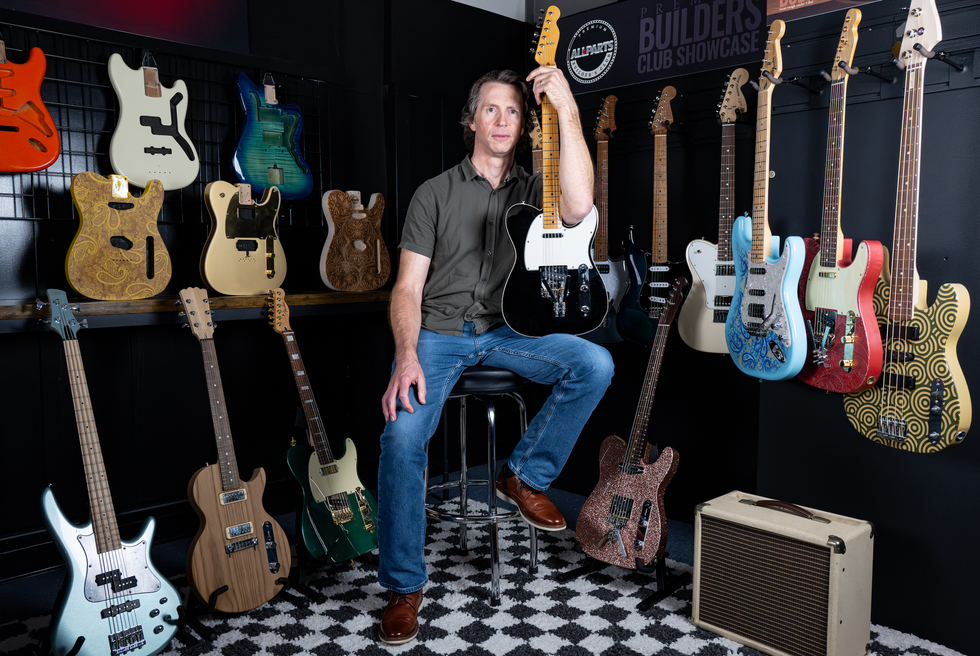
Throughout the years, Allparts—much like StewMac—has weathered economic shifts well, relatively speaking. While many American businesses have grappled with the effects of the Trump administration’s new tariffs, both Allparts and StewMac are navigating the situation carefully, and neither reports seeing much of an effect. Similarly to how Brock Poling of StewMac referred to a sizable share of the company’s product line as “recession-proof,” Herman sees opportunities for Allparts to thrive in virtually any economic situation.
“If the economy is great, people are buying guitars and basses, and builders need cool, differentiated parts that offer their customers something new they haven’t seen before,” he says. “But if the economy’s not great, the repair side of the business does better. So in our view, it’s always a good time to be in the parts business. It’s always a good time to be thinking about cool, innovative upgrades for musicians.”

